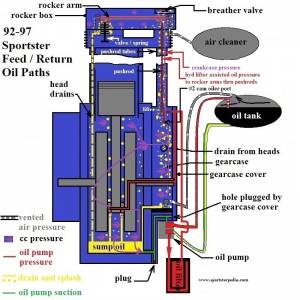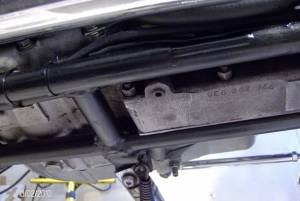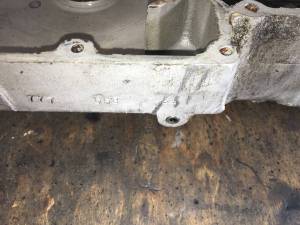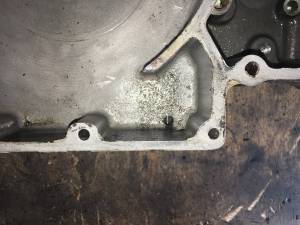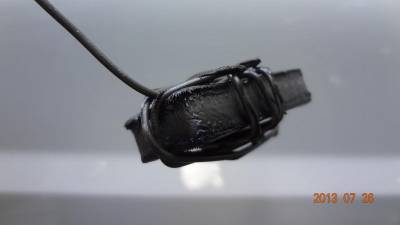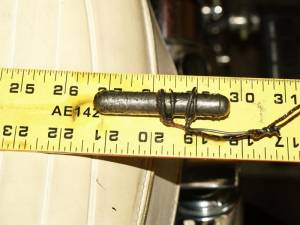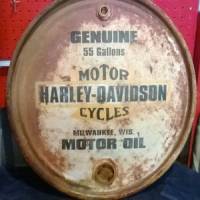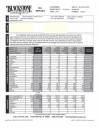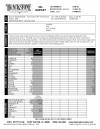Table of Contents
REF: Oiling & Lubrication
Engine Oil Change, Oil Specs, Aftermarkets and Comparisons
Further Oil Study
For a more in depth study on oil manufacturing, additives, specifications, etc., click here Getting More Technical about Engine Oil
 1)
1)
Checking Oil Level
Always check the oil after the engine is up to operating temperature before topping off the oil tank.
Flogging the bike with an immediate shut down could leave too much oil in the sump.
A forum member once reported that he went and flogged his buddies 06 bike. 2)
When he parked it, he immediately checked the oil level and it was about a quart down.
After a while he restarted it and ran it for just a bit before checking the oil again.
Low and behold the oil level was almost back to full.
So if your bike is in a current state of being wet sumped, it would definitely cause a false dipstick reading.
See more on Wet sumping in the REF section of the Sportsterpedia.
When checking the oil level before you fire up, don't be some are tempted to add oil then.
But the oil in the tank can leak into the engine during shut down times.
Adding oil on a cold motor may end up with having too much oil in the tank during the next ride.
See more on Sit Sumping in the REF section of the Sportsterpedia.
Overfilling the Oil Tank
This is a common mistake.
Most cars / trucks have a wet sump oil system where oil should always be present in the crankcase.
One could say the engine Is the oil tank.
To check oil, simply pull the dipstick, which runs straight into the crankcase, and read the level.
The Sportster is a dry sump oil system where (in theory) no oil should be accumulated in the sump or gearcase while parked.
The oil tank is separate from the crankcase.
All of the oil (except in lower extremities, i.e. oil lines, filter etc.) should be in the oil tank.
However, many circumstances will contribute to oil trickling down from the oil tank into the engine when it's not running (wet sumping).
Therefore, checking the oil level in the tank before running the engine to let the scavenge side of the oil pump send the oil back to the tank;
Can and most likely will result in seeing a lower oil level in the tank (since some of the oil has drained down into the engine).
This doesn't necessarily mean that the proper amount of oil is not in the system. It's just not all in the oil tank.
Before topping off the oil tank, run the engine if possible for about a 30 min. ride.
This heats up the oil to operating temperature and suspends the solids in the oil instead of laying on the bottom of the case.
This also allows the oil pump to send most of the oil in the engine back to the tank.
Failure to warm the engine first can result in an overfull condition in the system and you can end up blowing the cap off the oil tank and a big mess.
Filling up your oil tank can also result in the air cleaner breather puking oil also.
The return gears / gerotors in the oil pump are bigger than the feed side so it should clear out most of the sump and back to the tank once running.
(unless the oil pressure relief valve is opening too early with a weak spring on 86-91 models)
| Sitting for awhile, oil will most likely trickle down from the oil tank into the engine. 3) | Take the bike for a 30 min. ride before checking oil level. 4) |
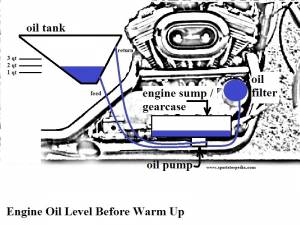 | 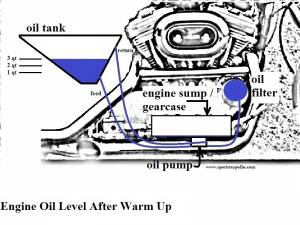 |
| Topping off the oil tank on a cold engine can result in adding too much oil. This can result in overage in the tank and spillage from the cap. This could also result in blowing oil out of the air cleaner. 5) |
|
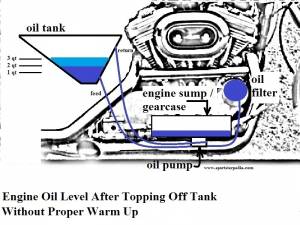 | 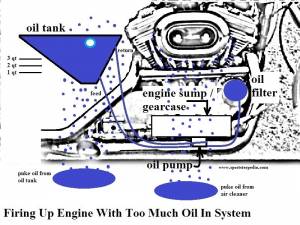 |
Why Does the Oil Smell Like Gas?
Fuel dilution in the oil is common on high mileage machines.
But this usually boils out on a long ride.
Short rides are killers on blow-by and water accumulations.
Regular oil changes should suffice. 6)
There is no way for gas to get into the engine other than thru the carb and past the float.
(unless you have an enemy pouring gas in the oil tank)
A problem with gas mixing with engine oil commonly starts at one place, the gas tank.
Most commonly it comes from not returning the petcock to the 'off' position after shutdown.
Gas seeps from the tank into the petcock, to the carb, past the float, into the cylinders, inbetween the rings and down into the crankcase, and the oil.
- Other situations can also attribute to gas getting into the oil supply.
- A leaking petcock (with the valve in the off position).
- Turning the engine over without it firing repeatedly dumps gas on top of non firing cylinders.
No boom boom equals gas that sits there just long enough to seep between the rings and down into the crankcase to mix with the oil.
This can happen when doing engine diagnostics such as a compression test or repeated rounds just trying to get the engine to crank. - A stopped up carb overflow drain.
It's important to first remedy the problem and drain / change the oil before running the motor.
Gas diluted oil will cause extra heat on bearings and engine parts and can cause engine failure.
Inspect / repair / replace the petcock.
Remove the fuel hose from your carb and direct it into a metal can or glass jar to see if the petcock leaks when shut off.
Note: Keihin CV carbs are vacuum operated by a diaphragm on the back of the petcock.
Unless the diaphragm isn't sealing, gas will not normally run out the petcock when the valve is on / motor off.
Carb vacuum actuates the diaphragm and allows gas to gravity flow thru the petcock.
Don't rely on the vacuum petcock alone, turn the gas off when the bike is not being ridden. 7)
It's better for them to be turned regularly anyway, as the rubber parts will bond together if they don't get lubed with gas and exercised once in a while.
Inspect the carburetor.
If the over flow hose is pinched off, gas will flow out the main jet if the float is set wrong or the needle valve is bad. 8)
You could try pulling off the float bowl and putting in a new float needle and generally clean out the gunk. 9)
A small piece of trash can get between the needle and seat (where the float attaches). 10)
This will let a trickle down the intake and into the cylinder.
An overly rich condition can also lead to gas contamination in the oil.
Check your air / fuel mixture.
An air screw (like on HSR42s) will be on the air cleaner side of the venturi (slide). 11)
A fuel screw (like on CV) will be on the engine side of the venturi.
Air screws cut off air, so they make the mixture richer when you turn them in (restrict an air passage).
Fuel screws cut off fuel when you turn them in because they shut off a fuel passage.
Drain the diluted oil, remove / flush the oil tank and replace with fresh oil.
Draining the tank does not drain the sump or the oil lines.
So you are leaving 'some' diluted oil in the engine (even though it was hot when changed).
Some ironhead engines have a dedicated sump drain and some do not.
77 and up engines have a rifled hole from the bottom up to connect the sump drain to the oil pump.
But removing that plug will not completely drain the sump as the hole doesn't enter the sump.
You can read more here in the Sportsterpedia on how to remove all or most of the oil in the sump by doing a
Scavenging Oil Change.
However, you can simply just drain the oil and replace it with something cheap long enough to heat it up to operating temp.
Then change the oil and try again until you've gotten all the gas out.
It may take a few oil changes until you've completely removed all of the gas.
Every future oil change will lessen that dilution but it just depends on how many changes that would take.
And then, it may still be a little while before the oil stops smelling of gas.
It smell will eventually gas out and go away.
You also may want to open up and refresh the oil pump.
The oil/gas would have circulated thru it.
It'd be good to replace the seals and inspect the oil check valve / ball also.
The gas can swell the seals and cause leaks.
Always turn the petcock 'off' when the bike is not being ridden to avoid the inevitable. 12)
If that fails, always turn off the ignition. You don't want accidental sparks while draining the gas out.
When To Change Oil
- After break-in, every 5,000 miles max. no matter what oil your using is the safe answer especially if your running petroleum based oil.
- When running synthetic oil, refer to the brand you are using for the length of time they specify.
One of the treats of using synthetic oil is that they offer extended oil change intervals.
Since the base oil is refined or hydrotreated even to hydrocracking to a point where the impurities in the base oil are lightly present to completely gone.
This, combined with good additives, allows the synthetics to work longer before breaking down. - It's your Harley and if you choose to use the intervals set out by your brand's recommendations;
Stick to them very close until you have had your used oil analyzed to make sure the oil is still doing it's job for your engine setup at those intervals.
The base lubricant may well be better.
But the additive package (which can be as much as 25% of the volume of product in the bottle) can still become exhausted. 13) - Oil can circulate several times before it ever passes through the filter because of pressure bypass valves.
So simply having an oil filter is not necessarily a suitable defense.
Leave the velocity stacks and open scoops to the drag racers that tear their engines down often.
Use a good filter and have your used oil analyzed by a good oil analysis company.
Without oil analysis and sophisticated computers, we can only approximate when to change oil in our motorcycles.
The manufacturer’s recommendation of 5000 miles seems a sound one given the information available.
For extreme conditions, adjust downwards slightly but a minimum interval should be kept at 3000 miles.
In the case of a catastrophic event, of course, change the oil immediately.
(I.E. - things like the carburetor flooding the crankcase, severe overheating resulting in the burning of the oil, or a failure of a mechanical part within the engine) 14) - XR-750 engine using Castrol R should not be stored longer than 1 month without draining and flushing the R residue from the system. 15)
HD Recommended Oil Change Intervals Per Year Model
| Year Model | Oil Change Intervals |
|---|---|
| 1972-2003 XR-750 | Every 1500-2000 miles under favorable conditions and a properly tuned engine.16) |
| 1959-1969 | Every 2,000 miles up to initial 5,000 miles then every 5,000 miles later (or one year)17) |
| 1970-1978 | Every 2,000 miles up to initial 5,000 miles then every 5,000 miles later (or one year)18) |
| 1979-1985 | After first 500 miles, then every 2,500 miles 19) |
| 1986-2003 | After initial 1,000 miles, then every 5,000 miles 20) |
- If you are riding in the city, you fire up your bike in the morning, drive 5 miles to work, then the ride back home in the evening
(while also sitting in a traffic jam)
You put a much larger amount of specific stress on the engine and on the oil than long distance rides on a highway. - It is not unrealistic to assume that if you do not reach the oil change interval specified in miles within 12 months,
then you are probably making these short trips and 1 mile of yours count like 5 or more (stress-wise) compared to the average.
So limiting the oil change interval in time as well as miles makes sure that the oil (that receives higher specific stress) gets changed sooner.21)
Should You Drain the Engine or Oil Tank?
On a normal oil change, none of us can drain All the oil out. When we drain the oil, we are only draining the oil tank and not the engine.
Do Not drain the oil until you've taken the bike on a 15-20 min ride. This will allow the oil to be scavenged by the pump to the oil tank.
It'll also suspend debris in the oil instead of it laying on the bottom and not being drained.
In gerotor oil pumps, the return side is much bigger than the feed side.
So firing up the bike sends the oil accumulated in the sump back to the tank faster than more oil can accumulate in the engine.
This fills the oil level back to where it should be. See also, Overfilling the Oil Tank above.
The drawing below shows the oil path for 1992-1997 Sportsters. All mini-sump engines are the same as far as oil scavenging goes.
The yellow portion in the bottom represents oil in the sump waiting to be picked up by the oil pump.
If you follow the path out the engine, the oil is sucked uphill from the sump to the oil pump.
This is why you need to run the engine until the oil is at operating temp before draining it.
Else you'll fill the line on the dipstick, pick up the oil in the sump upon startup and blow out it the breathers.
Changing / Draining Engine Oil
See also Drain Hose Locations per Year Model in the Evo Sportster section of the Sportsterpedia.
And Performing a Scavenging Oil Change for a more thorough removal of used oil in the sump.
Drain the old oil:
- Run the engine to normal operating temp.
- Remove the oil tank drain plug and allow the tank to drain completely.
- The drain hose from the oil tank is capped off below the tank.
- Loosen the hose clamp, drain the oil, put the hose back onto the frame plug and tighten the clamp. 23)
- You can use a Visegrip or hemostat to close the hose above the stud, slip it off the stud.
- Then open the line and let the oil drain into a catch pan / can.
(See above link for oil hose drain locations per year model)
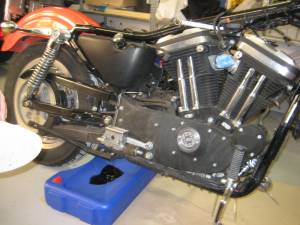 |
| Collect the oil, haul it to your nearest auto parts store for recycling. 24) |
Clean the lifter screen (86-91 only):
- Remove and clean the screen under the plug on the crankcase between the lifters.
Change the oil filter:
- Remove the filter
- Lube the mounting gasket around the new filter with oil.
- Install the new filter by hand tightening to 3/4-1 full turn after the gasket contacts the filter mounting surface.
- Pour about 4 fl oz (120 mL) of fresh, clean engine oil into the new oil filter.
(subtract that from the total amount added to the tank) - Allow time for oil to soak into the filter element.
| Add 4oz of oil to the filter before installing it. 25) | ||
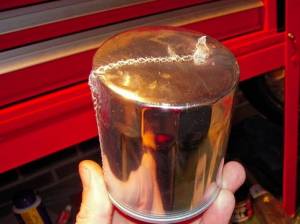 | 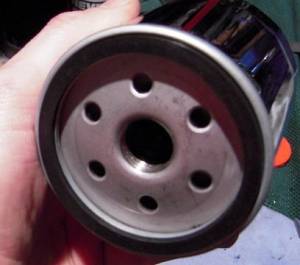 | 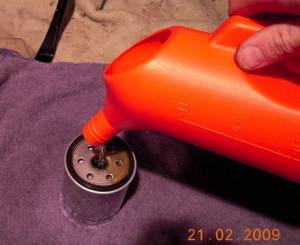 |
| Lube the outer gasket, place a rag under the filter mount and install the filter. 26) | ||
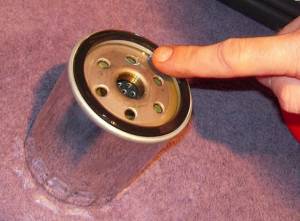 | 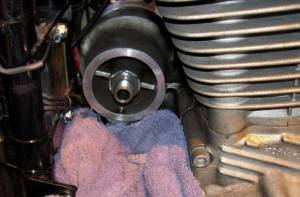 | 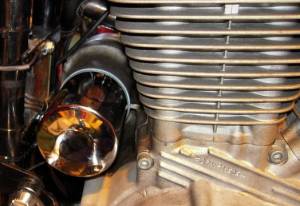 |
Add fresh new oil to the tank:
- Double check that you have the oil tank drain plug, plug between the lifters (if applicable) and the new filter tightened before adding oil to the oil tank.
- Check your FSM or owners manual for the total proper amount of oil to add.
- Pour the remaining oil into the oil tank.
- Fire up the engine, let the oil circulate and check for leaks around the drain plug and new oil fiter.
- Then, shut it off and add oil to the correct level if needed.
(most fill to halfway between the add and full line of the dipstick, not to completely FULL)
If you fill it completely full you may get oil coming out of the breathers into the air filter especially if you run for long periods at high rpms. 27)
Sportster Drain Plugs Explained
The dreaded case drain failure:
57-76 cases are notorious for cracked drain holes and thread damage around the sump drain.
77 and later cases are not.
This is due to the location of the 76 and prior drain plug.
See below for more information.
57-76 Cases
- The plug on the bottom left of the photo is the primary drain plug. 28)
- It is only used when draining the primary / tranny oil.
- The one above it in the photo is for the transmission. 29)
- Since the transmission shares the same fluid with the primary, and the primary plug is lower than the tranny drain plug, there is no reason to remove this one.
- The plug to the right center of the photo is the (crankcase drain plug). This is the one everyone has problems with. 30)
- (It has been said that ) this plug was never meant to be an actual case drain (in street engines). It's purpose has been somewhat of a debate. 31) See more below.
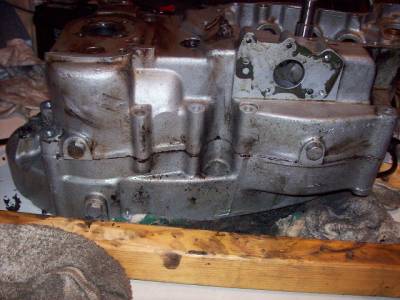 |
| Drain plugs in a '75 case 32) |
- Primary Drain Plug: 1/2“x20x1/2” 33)
So, if the only plug out of the three you'll ever need to remove (theoretically) is the primary drain plug, what is the purpose for the other two plugs?
- Transmission Drain Plug: 1/2“x13
- Crankcase Drain Plug: 1/2”x13 34)
- The drain on the pre1977 [non-mini sump] engine is under the flywheels, and was intended as a case drain. 35)
The 57 and 59 parts catalogs do specify “crankcase drain plug” while all others just read “drain plug” in the crankcase sections. 36)- We used either the pre'77 or we put one into '77-+ cases so that when racing, we could pull the plug in the pits to see how much oil was in the bottom end…helping to determine how much more restriction or bypass of feed oil we needed to eliminate, because the oil pump could not get rid of it. 37)
- If you are not requiring that knowledge, or don't intend to do anything about it anyway.
- According to one theory, the hole was needed for the casting and machining process only and the plug was never meant to be removed after it was installed at the factory. The MoCo couldn't provide information on exactly how the hole was used during the manufacturing process because AMF did not keep good records and also a lot of records were lost during the transition back from AMF. 38)
- Another theory is that people think the plug under the crankcase is a drain plug like you find on a car's oil pan and they remove it to drain excess oil collected in the case. 39)
- However, dry sump engines, like Harleys, drain from the oil tank, not the crank case. 40) Draining your oil tank and refilling it there is all we need to do for changing our oil. The amount of oil sitting in the bottom of the cases is trivial, and that lower drain plug is notorious for stripping and not worth the hassle. 41)
- A car is a wet sump system which most people are familiar with.
- Once removed, the plug will not tighten up again because the crumbly threads have stripped out.
- Right behind the plug sits the flywheels.
- You have about 3/8“ of air space between the wheels and the end of the plug. So a tap is not going to be able to get through to establish new threads.
- The best way to fix this correctly is to dismantle the entire engine and split the cases. Then you can tap out the hole but a better fix is to weld it over.
- Most people just use JB Weld to do their fix (?) and let it go at that.
- The depression in the pic below is from the boss on the plug smashing the case on over tightening.
Then, one time when the plug got removed, that piece of stressed aluminum broke free. 42) - The same thing can happen to the threads. They can break free upon removal of the plug for the same reasoning above.
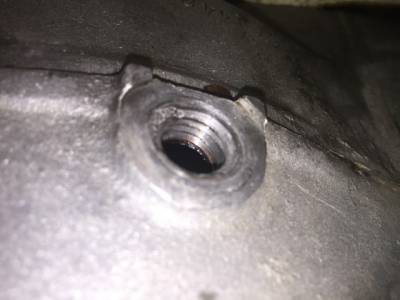 | 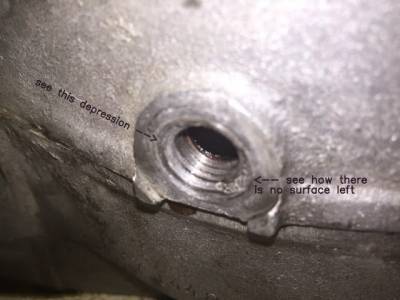 |
| Crankcase Drain Plug on a 1967 XLCH 43) | |
- Note that there will be no seal effect here because there is no surface for the plug boss to contact. 44)
- Oil will travel past the thread gaps and with no sealing surface, it will leak.
- That means a gasket may not effect a seal as there is not much for the gasket to squeeze against.
- In this case, some kind of pliable sealer (one that won't rip the threads out if you need to remove the plug again) smeared on the threads of the plug before installing it may work.
- If you use Teflon tape, you'll need to reduce the torque applied to the plug to keep from overloading the threads with wrench force.
Oil leaking around crankcase oil drain plug
- 1st thing to do is to make sure its the plug. It can be the case seam near the plug. If it is the latter, don't mess with the plug. Look for a weeping case seam and cracks between the plug threads and the case seam. 45)
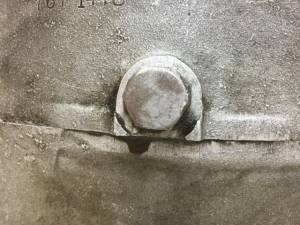 | 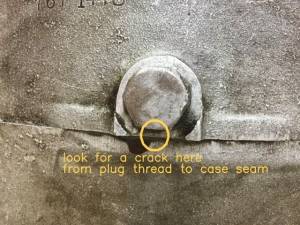 | 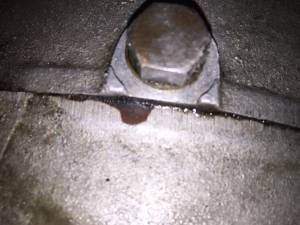 |
| Leak around oil drain plug. 46) In this instance, the case seam appears to be weeping oil. | ||
If your plug is a factory unit, and you can spin it in or out (once initial torque is broken) all the way by hand, you have no problems. As long as you don't over tighten it. Clean and install the plug with blue locktite. Then don't tempt fate again by removing it. If you want to try to remove / break plug loose, use 1/8 turn max. If you can spin out by hand see above. If it gets too tight to remove by hand after the initial 1/8 turn, GINGERLY put the wrench to it. If you feel even the slightest unusual resistance- stop (personally what I'd do is use a 5/8 deep socket only (no ratchet) in my hand. If I can get it out by doing that I MAY be safe for a no hassle re-install). Get whatever sealant you feel comfortable with in the small gap. then re-tighten GENTLY. 47)
UNDERSTAND THE PLUG DESTROYS THREAD INTEGRITY IN CASE ON REMOVAL. The thread may look ok but if they arent— you will know on re-torque. If you have a brass flanged washer on your plug, be very suspect of messing with it. These washers were used on XLH oil tank drains. That means someone has installed one on your drain plug. That can't happen unless the plug has been removed. Remember its ham fisted plug r&r that causes striped plugs. Think hard about that when looking at your brass washer.48)
- This one is cracked across to the edge of the case.
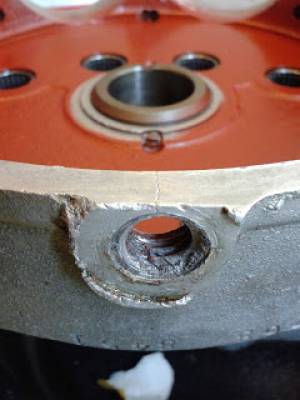 |
| Cracked case at the crankcase drain plug on a 1968 XLCH 49) |
L69-E71 Cases
Late 1969, all 1970 and some early 71 cases came with no motor drains from the factory. 50)
| 1969 XLCH with no sump drains. 51) |
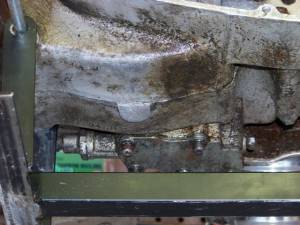 |
77 and Later Cases
The “drain plug” on the bottom of the case is either a pressed or threaded plug that caps the oil scavenging rifling hole. 52)
The MoCo drilled from the bottom of the case to the horizontal oil passage in the gearcase.
This connects the crankcase sump oil to the scavenge port of the oil pump and the hole is plugged on the bottom.
Some see this plug as a sump drain location while others view it as a permanent plug.
From inside the case with the plug removed from the scavenge passage;
In the second pic below, you can see that the threads, from the tap, have been machined farther up into this hole.
This is the oil passage from the sump to the scavenge pump.
Oil from cylinder drains, crankpin, pushrods and cam chest that collects in the sump is fed to the pump by crankcase pressure and pump suction through this hole.
Why are metal particles in the oil?
There will normally be a certain amount of metal 'mush' in the oil tank as engine parts wear.
The most (as in normal wear) will be evident at the first oil change after a fresh engine build.
This is where metal to metal surfaces cut and mold to each other.
You can drop a magnet wrapped in coat hanger wire into the oil tank and check for suspended particles.
The usual rule of thumb when viewing the magnet is look at the quality of the particles, not the quantity. 57)
You can take a pinch of the particles off the magnet and rub them between your finger and thumb.
If it feels soft and smooth like mud, all is ok.
It's like small clumps of very fine material. They array themselves like little tepees on the magnet. 58)
In cleaning them completely off with a paper towel, it looks like a mixture of oil and graphite on the towel.
If it feels gritty like sand and/or has larger particles like drilling chips etc, there may be a problem that needs addressing.
Recycling Your Used Oil
- Did you know used oil can be re-refined into base stock for lubricating oil?
If you recycle just two gallons of used oil it can generate enough electricity to run the average household for almost 24 hours. - We are all familiar with recycling newspapers, aluminum cans, glass and plastic bottles.
But you may not be aware of the efforts of the petroleum industry and other groups to promote used motor oil recycling.- Providing convenient collection sites for the purpose of keeping used motor oil out of our waterways and ground water supplies.
- And getting used oil into the recycling system.
- Motor oil has value even after it has been drained from an engine.
The oil you take to a collection center to be recycled can be reprocessed and used in furnaces, power plants, schools and businesses.
It can also be sent to a refinery that specializes in processing used oil.
There it can be re-refined into base oils that can be used to formulate engine oils meeting API specifications. - What can you do?
If you change your own oil, be certain that you take it to a collection center for recycling.
If you take your car to an automotive service outlet, you can be fairly certain that they recycle the oil that they change.
But if you're not sure, ask.59) - Many service stations, repair facilities and quick lubes will accept used oil and used oil filters.
Additionally, your local government or recycling coordinator may be able to identify curbside or other recycling programs in your area.
The best way of locating a nearby collection center is to visit the web site Earth911
Type in 'motor oil' or 'oil filter' and your zip code and local addresses will be shown for drop off services for recycling.
This web site allows you to search for collection centers by ZIP code and for any other recycling items.
It also has information on recycling other items like batteries, electronics, and aluminum.60) - You can also contact most any auto parts store and even a participating Walmart for drop off recycling.
Choosing an Engine Oil
What Kind or Brand of Oil To Use for a Sportster
- 61) First answer is to use the HD recommendations in the Factory Service Manual (FSM) for your year model.
The chart below shows some recommendations for the use of HD oils.
And you can contact your nearest HD dealer for current recommendations on the oil they are selling for your ride.
See also Choosing an Engine Oil Other Than HD Brand - The MoCo has a vested interest in keeping your engine healthy and knows exactly what oil their engines like.
Plus, no one ever damaged an engine by changing its oil too often.
If you want to keep your engine healthy, regular oil changes using the recommended weight and quality of oil is the easiest way to do it. - Development of Genuine Harley Davidson Motorcycle Oil. 62)
In the late 70's, complaints were received by the MoCo from recreation and touring riders experiencing valve sticking problems.- It was found that touring bikes had the highest engine temps.
- Typically, when riding down the highway in hot temperatures, the steady blast of air cools the engine.
- Coming off the highway and stopping at lights, stop signs and riding in dense traffic prevents or slows the air onto the engine for cooling.
- The heat in the engine increases the critical temp to rings and exhaust valves.
- The oil breaks down, carbon is formed as lubrication breaks down and the valves stick.
- It all happened very quickly and without warning.
- The problem increased as gas formulations changed due to EPA regulations.
- These changes caused increased operating temps and the problem got worse with more EPA restrictions on exhaust emissions.
- Through a great deal of testing, a formula was produced with an (exclusive to Harley Davidson) additive package that did reduce the oil temps.
(and stopped the sticky valve problem) 63)- Using a dynamometer, a test cycle was developed to reproduce the sticky valve condition.
- The test engine would was ran under load for a period of time and idled for five minutes.
- The cycle was repeated without stopping the engine with the engine continuously monitored for the duration of the test cycle.
- The engine was then repaired with blueprint parts to ensure specific running clearances, given proper break-in and the test was repeated.
- Each oil sample was run in separate tests for a min. of three times with fresh oil for each test.
- The sample oil rating was obtained by taking the average number of hours run in each test.
- Therefore, HD 240 oil was labeled meaning that the tests take an average of 240 hours before the min. test criteria was reached.
- The closest any other oil came to the testing criteria was 220 hours.
(but that was the best synthetic which, at the time, cost an average of four times that of the Harley oil)
Current HD Engine Oil Recommendations
- Use proper grade of HD (or equivalent) oil for the lowest expected temperature before next oil change. 64)
| Year Model | Amount (with filter replaced) |
|---|---|
| 1959-1978 | 3 quarts (2.8 liters) |
| 1979-1981 | 4 quarts |
| 1982-2003 | 3 quarts (2.8 liters) |
| 2004-2007 | 2.8 quarts (2.65 liters) (see below) |
- Tech Tip #312 - 6/15/07 - Quote: 2004-2007 Sportster Oil Capacity - Service literature for 2004-2007 XL models incorrectly lists oil capacity as 3.6 quarts (3.4 liters). The correct amount listed should be 2.8 quarts (2.65 liters). Oil capacities listed are approximately the amount required to bring the fluid level near the full mark on the dipstick. Service Note: Be aware that the dipstick has a Full mark to indicate the highest level of oil that should be installed in a hot engine and an Add mark to indicate the lowest level of oil in a cold engine. The engine is designed to operate correctly with the oil level in the range between these two marks. While it is most important to not overfill the system, it is acceptable to operate the motorcycle with the oil level anywhere in the range between the Full and Add marks. 67) (This may be oil change only without the filter.)
| HD Type Oil | Viscosity | HD Rating | Ambient Temp. | Cold Weather Starts Below 50F |
|---|---|---|---|---|
| Screamin Eagle Syn 3 (fully synthetic) | SAE 20W50 | HD360 | Above 30F(-1C) | Excellent68) |
| HD Multi-grade (petroleum) | SAE 20W50 | HD 360 | Above 40F (4C) | Good69) |
| HD Mulitigrade (petroleum) | SAE 10W40 | HD 360 | Below 40F (4C) | Excellent 70) |
| HD Regular Heavy (petroleum) | SAE 50 | HD 360 | Above 60F (16C) | Poor71) |
| HD Extra Heavy (petroleum) | SAE 60 | HD 360 | Above 80F (27C) | Poor72) |
| In the absence of HD 360 oils, HD recommends using oil certified for diesel engines73) | |
|---|---|
| Acceptable API Ratings | Acceptable SAE Viscosity Rating in Descending Order |
| CH-4, CI-4 and CJ-4 | 20W-50, 15W-40 and 10W-40 |
| At the first opportunity, change back to Harley Davidson Oil | |
HD Engine Oil Recommendations Per Year Model
| Racing Applications for the XR-750 (only) | |
|---|---|
| Since 1972, HD racing department's recommendations for this engine has been to use Castrol R or comparative synthetics. However, do not mix Castrol R with mineral oils. Flush with flushing oil or Castrol R before running any mixed oils to avoid oil separation and deterioration of performance due to the balance of the inhibitors being upset. | |
| Castrol R 30 | In cold weather, particularly for short circuit or sprint events, or races of short duration where it is essential for a more rapid warm up time, it is the best grade to use for general competition purposes. |
| Castrol R 40 | Used for maximum protection when the greatest film strength and lubricity is needed i.e. during sustained speeds in high performance 4 cycle engines. Similar to other SAE 40 racing oils, is relatively viscous when cold. Circulation may therefore be sluggish in colder weather immediately following startups. |
| Year Model | Harley Davidson Type Oil | Ambient Temperature F |
|---|---|---|
| 1959 to 197874) | HD 58 | <40F |
| HD 75 | 40F and up | |
| HD 105 | Severe engine operating conditions >90F | |
| 1979 to 198575) | HD Special Light | <40F |
| HD Medium Light | 40F to 60F | |
| HD Regular Heavy | 60F and up | |
| HD Premium II Extra Heavy Grade 60 (API SF) 76) | severe engine operating conditions >85F |
| Year Model | Harley Davidson Type Oil | Viscosity | HD Rating | Ambient Temperature F | Cold Weather Starts Below 50F |
|---|---|---|---|---|---|
| 1986 to 199077) | HD Multi-Grade | SAE 20W-50 | 240 | 20F-100F | Excellent |
| HD Regular Heavy | SAE 50 | 240 | >60F to 100F | Poor | |
| HD Extra Heavy | SAE 60 | 240 | >80F-100F | Poor |
| Year Model | Harley Davidson Type Oil | Viscosity | HD Rating | Ambient Temperature F | Cold Weather Starts Below 50F |
|---|---|---|---|---|---|
| 1991-200378) | HD Mulit-Grade | SAE 10W-40 | 360 | Below 40F | |
| HD Multi-Grade | SAE 20W-50 | 360 | Above 40F | ||
| HD Regular Heavy | SAE 50 | 360 | Above 60F | Not recommended below 50F | |
| HD Extra Heavy | SAE 60 | 360 | Above 80F | Not recommended below 50F |
Choosing an Engine Oil Other Than HD Brand
- Easy answer is to choose an oil brand that is formulated for 4-stroke motorcycle engines with a viscosity comparable to your HD recommendations.
- Why? Because most of the current motorcycle engine oils are formulated with good base stocks with some sort of additive package(s) for wear protection and shear strength.
- Know your SAE and API ratings. Choosing an Oil by SAE Rating and Choosing an Oil by API Rating
- Synthetic or Petroleum? Petroleum for break-in, after that it's your choice. See also Conventional VS Synthetic for comparison and Base Oils and Refining to see how synthetics are made.
- Here are some Engine Oil Comparison Charts with information from different oil manufacturer’s Safety Data Sheets (SDS) and Technical Data Sheets (TDS) if you want to see some property comparisons of different oils brands and viscosities as stated by the various manufacturers. You can compare your favorite brand’s SDS/TDS with those in the chart to see how it fares with them. If yours is not in the chart, you can go to your oil brand’s website to see their information to compare with. Or you can send a request to the Sportsterpedia through the XLFORUM to have it listed.
- Regardless of the oil you choose for your engine, it’s a good practice to change it per the change intervals in your FSM no matter what Brand X oil company says you can do with their ‘best you can buy’ oils. For optimum oil change intervals, have a used oil analysis (UOA) done when you change it to see what your engine’s needs are. This is not a hugely expensive procedure when you look at the big picture. After all, for most, a motorcycle is kind of like a member of the family. See also When to Change Oil
- However, a single UOA sample shows very little. Regular sampling gives you excellent information, but you must know how to use it. 79)See also Used Oil Analysis Charts
- Some oil companies will state higher change intervals with their highly refined oils. However, each engine is different with different needs and factors such as engine/ modifications, age, wear/ riding style, engine use/ dynamics, racing, daily rider, seasonal rider and the list goes on. No oil brand can take up for all these factors no matter what is in the additive package(s).
- Beware of advertising, there is a lot of hype in marketing and some just downright lies and deceptions from different oil manufacturers who are all competing for your business. There is also a 100% chance that your favorite oil brand is intentionally not telling you the full unadulterated truth about what is in or not in their oils and how it’s going to affect your engine other than theirs is the best anybody could ever use.
- Word of mouth has always been a good way to find the true value of products. However, keep in mind that we are all humans and it’s easy for anybody to be misled by the said advertising hype that you sometimes need a degree to even understand some of it. The reasons for a person’s oil preferences can range from price, availability, used oil analysis (UOA), comfort in advertising to dishonest oil company practices/ claims and all the way to mythical unicorns that plague the internet.
- Several Used Oil Analysis Charts from your engine should tell you if you made the right choice.
Choosing a Single Engine Oil That's Also Safe for Primary and Transmission
- Check the label or Technical Data Sheet for the brand your wanting to use.
- It should have a JASO MA, MA1 or MA2 rating which is safe for wet clutches.
- A JASO MB rating is not safe for wet clutches according to the JASO T 904:2006 clutch system friction test as it has too many friction modifiers in it. Oil brands that are rated JASO MB do publish that it is NOT safe for wet clutches.
- If the JASO rating is not published, contact the company or check the brand's TDS to see if they at least publish that it is safe for wet clutches.
- The Engine Oil Comparison Charts also include any published Jaso ratings and wet clutch verbage from the respective brands sampled.
- See more about JASO Oil Specifications for wet clutch transmissions.
Engine Oil Comparison Charts
- These charts were compiled solely from SDS, TDS and other published data from the respective companies. There are many brands on the list and many more that are not. The charts serve as a comparison to oil company claims as well as to what you are using. However, a used oil analysis will confirm more about the oil you use for your engine than these charts can. If your brand is not included here, you can search their respective website for MSDS, SDS, TDS, and PDS information where you can find all the information available from them as is included in these charts.
- MSDS (Material Safety Data Sheets), which has been renamed to SDS (Safety Data Sheets) and TDS (Technical Data Sheets) which is also published as PDS (Product Data Sheets). You will find that some manufacturers do not update their charts as well as others. You will also find that some information in the SDS is different than the information in the TDS of the same oil bottle.
1-A to B 2-B
2-B 3-B to E
3-B to E 4-E to G
4-E to G 5-H
5-H 6-I
6-I 7-I to L
7-I to L 8-L
8-L 9-L
9-L 10-L to M
10-L to M 11-M
11-M 12-M
12-M 13-M
13-M 14-M to P
14-M to P 15-P
15-P 16-P to R
16-P to R 17-R
17-R 18-R to S
18-R to S 19-S
19-S 20-S
20-S 21-S to T
21-S to T 22-V
22-V
Getting More Technical About Engine Oil
Choosing an Oil by SAE Rating
- SAE uses numbers to indicate viscosity (flow-ability). Thin oils have low numbers and thick oils have high numbers.
- Single (or straight) viscosity oils may be shown as SAE 30 or SAE 60 and generally have a thicker base oil than multi-grade oils.
- Multi-grade oils have a “W” after the number indicating the viscosity was tested at low temperature to simulate cold weather operation. Multi-grade engine oils fall into the 5W30 to 20W50 range. For example a 10W50 grade oil is less viscous, or thicker at lower temperatures (10) and more viscous, or thinner at higher temperatures (50) which allows the engine to operate efficiently over a wide range of operating temps. 122)
- Before settling on an oil brand just for the SAE viscosity rating, other than the fact that it matches the viscosity stated in the FSM, it is notable that all SAE 60 weights are not the same just as all SAE 20W50 weights aren’t the same. There are different base stocks Base Oils and Refining and additives Oil Additives to consider.
Choosing an Oil by API Rating
- Choose an oil made for 4 stroke motorcycles with an API rating API Oil Specifications that is pre-API SM with an SAE viscosity comparable to HD recommendations for your bike. Most motorcycle oils are formulated with the API SG, SH and SL ratings range. There are lower viscosity grades that also carry the same API ratings as the higher ones.
- Zinc dialkyl dithiophoshate (or ZDDP) ZDDP is the proven and trusted anti-wear agent (basically a mix of Zinc and Phosphorous) that is being slowly phased out from oil products by mandates from the EPA.
- API SG to SL generally have more ZDDP included to guard against metal to metal contact in your engine.
- Shooting for an oil brand with app. 1200 ppm or higher ZDDP (API SJ) is good starting point.
API Oil Specifications
- Currently there are no engine oil standard testing specs API Oil Specifications specifically designed for motorcycle use. Therefore, you must choose a motorcycle oil based on specs written for modern automobile engines (with their primary concern being the protection of catalytic convertors and with their next concern being Eco friendly). Most oil brands that are specifically formulated for motorcycles still incorporate the older API specs.
- Consequently, oil is graded by the American Petroleum Institute (API) in several categories. Some oil containers display this information on their labels and some print it all over the label or not at all. You can also do an internet search for the Technical Data Sheets (TDS) of an oil brand which should show their testing ratings as well. Most of the time the API rating will not be listed in their Safety Data Sheets (SDS). Truthfully, more petroleum based oil brands do not print this information than synthetic oil brands. The API grade is indicated as a letter and identified by an “S” (service vehicle) for gasoline engines in the older HD repair manuals as in “SE” or “SF”. API has abandoned use of these and other successor grades for the use in automobile gasoline engines.
- The API rating(s) of an oil gives information related to the oil’s contents. Though not infallible, the basis for the numbers found on a bottle of oil represents that oil company’s adherence to certain standards set out by API through testing procedures. It is conceivable that all of manufacturers perform a lot of testing on their oils but the testing data is subjective that is published to their consumers which can lead to confusion and dis-trust.
- Understanding the label on the oil is not easy. Oils rated SN or SM must have between 600 ppm and 800 ppm of phosphorous. They could be rated SL and have up to 1000 ppm of phosphorous or more. But if there is a CI-4 in front of the SL (CI-4/SL) there is no limit on the amount of phosphorous, and a fully formulated CI-4 oil made with synthetic or group II+ base stock will typically only have about 1350 ppm of zinc and 1200 ppm or so of phosphorous. With a better the base stock, less additives are required for the same performance. If there is a CJ-4 in front of the SN, SM, or SL, it is limited to 1200 ppm of phosphorous. 123)
- The API rating started pre-1930 with an API SA lettering code. Over time, the API classifications evolved to their changing demands from the industry. A lot of the older classifications were not only dropped but also banned against due to the improving refinery techniques and healthier base oils with stronger additives that were being produced with less mechanical issues toward engines. API doesn’t qualify oils based on additive levels, but rather on performance which is determined by base oil and additives. The API SC or SD oils of the late 60s had only 800 ppm of detergent and app. 510 ppm (parts per million) of zinc combined with 480 ppm of phosphorous. At that time, little was known about the rate of evaporation of different phosphorous compounds and their effect on the length of time that the oil could provide adequate boundary lubrication .124) API SH class offers 0.130% zinc and 0.120 phosphorous.
- SN rated oil is generally not healthy enough for a motorcycle engine (or an older, flat bottom tappet/ lifter, car engine) without a heavy additive package. As oils change from SJ to SL and to the newest, 125) the additive packages are different. The Brand with grade SJ you used last year is not the same as the same Brand grade SL you are using this year, even though the packaging may be the same. 126)
- It should be noted that, with the exception of California, there are no laws that prohibit the sale of engine oils identified by the API as having an “obsolete” status.127)
Conventional VS Synthetic
- In time, any engine lubricant will have a diminished ability to perform its job, which is to lubricate metal-to-metal contact surfaces and to transfer heat away from the area being lubricated.
- Heat and oxidation are the primary reasons for oil break down. The diminished ability to lubricate increases as the molecules of various size and weight are consumed by evaporation and oxidation.
- Lubrication ability may continue to diminish as these various molecules interact with the blow-by gases and other contaminants in the engine environment.
- Additives are used to control acid, stabilize viscosity, keep soot in suspension and reduce metal to metal contact point wear. The additives are typically consumed as they do their job.
- The longer a lubricant can resist breaking down, the longer it can be used. 128)
- However, regular oil changes per the FSM will allow ANY 4T motorcycle oil with proper viscosity rating regardless of base stock to perform adequate for a Sportster.
- Oils marketed as “High Mileage” usually are prepared with extra additives than nominal viscosities that reduce the possibility of leaks and oil consumption. This is achieved through the use of seal swelling agents that reduce leaks and thicker oil viscosity which can curb oil usage in some situations. But it really is nothing more than a Band-Aid masking a bigger problem within the engine and can do more harm than good129).
- Conventional Oil: Petroleum-based lubricants are mixtures of several sizes of hydrocarbon molecules, sulphur, paraffins, salts and metals.
- Pros: Lower cost than synthetics
- Standard petroleum motorcycle oils usually contain a healthy additive package with some including synthetic-derived additives.
- HD oils are petroleum based with no damage to the engines when changed at recommended intervals
- While breaking in an engine, you want the oil to NOT get in the way of your metal parts cutting in and melding together. Petroleum oil's faster deterioration promotes break-in more than synthetics.
- Cons: With different evaporation, oxygenation and burn points for each size and type of molecule, the refined petroleum-based oils start changing to an extent the moment you start your engine. 130)
- The fastest and most significant drop in the viscosity of petroleum-based oils used in motorcycles occurs during the first 800 miles (or less) of use.131)
- Conventional oils also contain the viscosity index improvers to resist thinning at high temperatures. These additives along with other impurities tend to shear down and boil off as well. All of these factors tend to contribute to oil consumption and depositing.132).
- Synthetic oil: The word “Synthetic” is a marketing term, not a technical term and is not part of the API Classification. 133)It is purified and broken down into its basic molecules. This process not only removes more impurities from the crude oil but also enables individual molecules in the oil to be tailored to the demands of modern engines. These customized molecules (with a tailored blend of additives) provide higher levels of protection and performance than conventional oils.134)
- However, just using an oil brand that says synthetic on the bottle is only half the story. Some oils branded synthetic only use a higher refined mineral oil base and are lawfull in advertising but not historically correct.
- Synthetic blend oil is a mix of conventional motor oils and synthetic base stocks. Because of the added synthetic base stock, you’re going to get more performance and protection than you would by using a conventional oil alone. This 'hybrid' base oil is mixed with a variety of additives that boost the performance of the oil. The additives rely on a carrier solution for mixing them that is most often petroleum based although they can still lawfully use the term 'full synthetic'. So, higher end semi-synthetics can be confusing especially through deceit in marketing. Synthetic blends generally fall in the category of group III oils although some group II oils may take some liberties. Depending on the marketing hype you may read, some 'special blends' will be magically classified as a full synthetic base oil. Reference the oil brand's Safety Data Sheets (SDS)when in doubt.
- Pros- The viscosity of synthetic-based oils generally drops more slowly than that of petroleum-based oils in the same application. Some blends perform equally and at a lower cost than full synthetics.
- Cons- Semi-Synthetic oils offer longer time periods between oil changes compared to using regular motor oil.
- Deception in advertising turns some people away from blends(semi-synthetics) when advertised as full synthetics.
- Cost. Synthetic blends cost more than conventional oils although it's quite possible to catch a sale or two from time to time. 135)
- Full synthetic oil is a group IV Polyalphaolefin (PAO), oil base (often called synthetic hydrocarbon) and uses a synthetic base stock also mixed with a variety of additives that boost the performance of the oil. While all synthetics on the market may offer a higher level of protection than conventional or synthetics blends, not all synthetics are equal. Each synthetic brand uses a mix of high-performance fluids and additives. How these formulations come together results in various protection levels and attributes. 136)
- Pros- PAOs are improved oxidative and thermal stability, excellent de-emulsibility and hydrolytic stability, a high viscosity index and very low pour point. Most of the properties make PAOs a good selection for extreme temperatures (both high operating temperatures and low start-up temperatures). 137)
- Synthetic oils offer longer time periods between oil changes compared to using regular motor oil.
- Cons- PAOs are expensive and have poor solubility. Most hunt for sales or use one of the semi-synthetic oils. The low inherent solubility of PAOs creates problems for formulators when it comes to dissolving additives. Likewise, PAOs cannot suspend potential varnish-forming degradation by-products, although they are less prone to create such material.138)
Car Oil vs Motorcycle Oil
- Motorcycles are harder on oils than cars.139)
- The viscosities of petroleum-based oils, whether designed for auto or motorcycle application, drop at approximately the same rate when used in a motorcycle.140)
- Based on testing data, there is no validity to the constantly-used argument that motorcycle-specific oils provide superior lubrication to automotive oils when used in a motorcycle. If the viscosity drop is the only criterion, then there is certainly no reason to spend the extra money on oil specifically designed for motorcycles. There does, however, appear to be a legitimate argument for using synthetic and synthetic-blend car oils over their petroleum based counterparts. 141)
Base Oils and Refining
- The American Petroleum Institute (API) has categorized base oils into five categories (API 1509, Appendix E). The first three groups are refined from petroleum crude oil. Group IV base oils are full synthetic (polyalphaolefin) oils. Group V is for all other base oils not included in Groups I through IV. Before all the additives are added to the mixture, lubricating oils begin as one or more of these five API groups.142)
- There are several different base oils available to formulate motor oils. The base oils used in the 1960’s are what we now call API Group I, although some fall in the high aromatic sub classification and then some in the low aromatic sub-classification (important when discussing additives). Some companies also use their own marketing phrases like “Group 1-1/2” and “Group 2+”.
- Group I oils (considered mineral oils, or “dino” oils) continue to be marketed, but in the US it is more common to find API Group II (still considered to be mineral oils), some API Group II+, more API Group III (considered “synthetic” after Mobil lost an argument against Castrol), and mixtures of API Group IV and V (traditional synthetics). The original synthetics were pure Group IV base stocks, and due to lack of solvency did not mix well with the residuals of Group I and Group II oils and shrunk oil seals, creating the concept (Myth) that you cannot change to synthetics after using mineral oils.
- Group I oils are solvent refined and normally low in natural viscosity index, although some oil fields produce better grades than others. They have 20 to 30% aromatics, high nitrogen, less than 90% saturates and/ or more than 300 ppm sulfur and viscosity index (≥80 - <120).
- The temperature range for these oils is from 32 to 150 degrees F.143)
- Group II oils are hydroprocessed oils (or solvent refined and then hydrotreated). Normally 92% to 99% of the molecules are saturated in the bombardment of hydrogen, creating a cleaner, stable base oil, viscosity index (≥80 - <120) and eliminating more aromatics, sulfur (≤300 ppm), and nitrogen.146)147)
- Group II+ oils are hydroprocessed to a quality somewhere between Group II and Group III.
- Group III oils are severely hydrocracked, (higher pressure and heat). Although made from crude oil like groups I and II, this longer process is designed to achieve a purer base oil148) that under some conditions give equal performance to traditional synthetic oils.
- Group IV oils are PAO (Polyalphaolefin) synthetics . These are excellent lubricants but have very low solvency when used by themselves, not mixing well with other oils, additives or contaminants, and causing hardening of seals and gaskets. Fully formulated PAO based oils use esters or other ingredients to increase their solvency. These synthetic base oils are made through a process called synthesizing. They have a much broader temperature range and are great for use in extreme cold conditions and high heat applications.151)
- Group V oils are everything else synthetic including silicone, phosphate ester, polyalkylene glycol (PAG), polyolester, biolubes, etc.152) In general the esters and diesters of various formulations are used to mix in small percentages with PAO oils to give the necessary solvency and help them maintain a clean engine, softening the seals to avoid leakage. Ester oils can take more abuse at higher temperatures and will provide superior detergency compared to a PAO synthetic base oils.153) The category also includes other types of oils used for specialty products or to thicken group I, II, III or IV oils. 154)
De-waxing
- Paraffinic crudes need to be de-waxed. In de-waxing the oil is blended with a solvent with which it is miscible. The mixture is cooled, the N-alkanes will crystallize and can then be filtrated off. The solvent is subsequently removed by distillation.155)
Extraction
- Extraction is one of the oldest methods of removing unstable molecules from a distillate. The oil is mixed with a solvent (SO2 or furfural) that forms a separate phase. Aromatic and hetero-aromatic molecules will to some extent dissolve in the solvent phase and can be removed. Due to the equilibrium between the two phases, the amount of aromatics in the raffinate phase lies between 5 and 11%. After the extraction step, a mild hydrogenation is usually performed.156)
Hydrogenation
- De-waxing and extraction are based on physical methods. Hydrogenation is a chemical conversion of undesirable and environmentally dangerous molecules into harmless compounds.
- In hydrogenation, polar, aromatic and hetero-aromatic compounds are adsorbed on to a catalyst surface. The active surface of the catalyst is up to 200 m2/g. Here, the molecules are made to react in the presence of hydrogen.
- At low severity – i.e. low pressure, low temperature and high space velocity – only sulphur, oxygen and nitrogen will be removed, forming H2S, H2O and NH3.
- By increasing the severity, the aromatic rings become increasingly saturated and, to a certain extent, opened. Since the polyaromatics are the most reactive compounds, the major part of the aromatic compounds remaining in the oil will consist of stable monoaromatics.
- The hydrotreatment process is an environment-friendly process which converts undesirable polyaromatic molecules into useful compounds. The result is a high yield of products and little waste products. 157)
Hydrocracking
If the oil is hydrogenated even more than in the severe hydrotreating process, the naphthenic molecules are opened. This results in the so called unconventional, or semi-synthetic base oils known as VHVI (very high viscosity index) and XHVI (extra high viscosity index) stocks. The main application for these oils is in automotive lubricants.158)
Oil Additives
- In the 1930s a wax modifier was added to oil to address the problem of wax residue after the refining process. Thus began the use of additives in the formulation of motor oil. Today, motor oils contain a variety of ingredients designed to improve their performance capabilities. 159)
- The more stable the base oil, the less additives are needed. In general a Group II oil will have better performance with 10% less additives than a Group I oil.
- As running time accumulates, the additives degrade and the oil “falls out of grade.” In essence, your 10W30 turns into a 10W20 or worse, hence the need for regular oil changes.160)
SURFACE PROTECTION ADDITIVES
- Anti-wear agents reduce friction and wear, help prevent scoring or seizure and help prevent metal-to-metal contact by providing a film of lubrication when oil is squeezed out from between moving engine parts.
- Friction modifiers strengthen the oil film and prevent un-lubricated contact between moving parts. 161)
- Corrosion and rust inhibitors are used to protect against rust an corrosion of metal parts due to acids and water formed in an engine.
- Detergents keep surfaces free of deposits like varnish and sludge on engine parts and neutralize acid formed in the engine.
- Dispersants keep down insoluble contaminants by suspending them so they don't form deposits in engine.
PERFORMANCE ADDITIVES
- Pour point depressants enable lubricants to flow at lower temperatures in a cold engine, especially in cold weather, by modifying wax crystal formation thereby reducing interlocking.
- Seal swell agents help to swell elastomeric seals by causing a chemical reaction in the elastomer.
- Viscosity modifiers help reduce the rate of viscosity change when temperatures rise or drop. Because the VI improvers are long, delicate chains of molecules, they're subject to lots of wear and tear. They can be sheared by gears, for instance, and torn apart by the wiping action of cam followers. They are a key additive in the production of multi-grade oils. Mineral and hydrocracked (petroleum synthetic oils) require more VI improvers than proper PAO/Ester (Group IV or V). Synthetic oils have a higher inherent VI to begin with, this is due to differences in the molecular structure of the synthetic base oils compared to mineral oils. 162)
PROTECTIVE ADDITIVES
- Anti-foamants reduce surface tension and speed the collapse of foam churned up by engine crankshaft. Foam reduces lubricating effectiveness.
- Antioxidants slow the rate of oxidation by decomposing peroxides and terminating free-radical reactions and also prevent oil from thickening when it runs hot for extended periods.
- Metal deactivators are used to reduce catalytic effect of metals on the oxidation rate.
Mixing Oils/ Oil Additives
Many oil manufacturers publicize that their synthetic oils can be mixed with other synthetics as well as petroleum oils but the practice is discouraged due to the fact that in doing so would alter the additive blend and general base qualities of the mix with possible detrimental effects to your engine.
Additive Specifics
ZDDP
- Zinc Dialkyldithiophosphate (ZDDP) is a last resort protection against metal-to-metal contact. Motorcycles are no more prone to metal-to-metal contact than automotive engines. However, improved viscosity maintaining compounds reduce the possibilities that this will be an issue.
- ZDDP is activated by heat and pressure. Until an engine warms up the layer left from the day before is wiped off and not replaced. This is another reason not to race an engine until it is hot.
- In regards to concerns over the reduction of ZDDP in API-SM rated motor oils. The concentration of ZDDP in such oils has varied through the years in response to the needs of changing engine technology. In 2004, however, the US government mandated 120,000 mile lifetimes for catalytic converters, and since phosphorous contaminated them, the phosphorous content of oil had to be reduced. Modern API-SM oils have reduced levels of ZDDP, to a greater or lesser degree. Zinc content is usually used as a measure of ZDDP content, although phosphorous is really the critical element. Phosphorous levels are typically 75% to 90% of the zinc concentration. The zinc concentration is often given in parts per million by weight (PPM); 1000 PPM is 0.1%. Maximum zinc content today is rarely more than 0.08% (800 PPM), compared to approximately 0.12% (1200 PPM) previously. Some modern oils have considerably less.
- In general, however, this is not a dramatic reduction of ZDDP. A higher level of ZDDP was good for flat-tappet valve-train scuffing and wear, but it turned out that more was not better. Although break-in scuffing was reduced by using more phosphorus, longer-term wear increased when phosphorus rose above 0.14%. And, at about 0.20% phosphorus, the ZDDP started attacking the grain boundaries in the iron, resulting in camshaft spalling. So, more is not necessarily better. It’s a good idea to keep this in mind before using high-ZDDP racing oil, diesel oil, or any other additives in a street engine. 163)
Phosphorus
Phosphorus is a key component for wear protection in an engine and 1600ppm (parts per million) used to be the standard for phosphorus in engine oil. In 1996 that was dropped to 800ppm and then more recently to 400ppm - a quarter of the original spec. Valvetrains and their components are not especially cheap to replace and this drop in phosphorus content has been a problem for many engines. So why was the level dropped? Money. Next to lead, it's the second most destructive substance to shove through a catalytic converter. The US government mandated a 150,000 mile lifetime on catalytic converters and the quickest way to do that was to drop phosphorus levels and bugger the valve train problem.
Boron Additives in Oil
By MolaKule 164)
- This white paper discusses the mechanics and chemistry of Boron Compounds as additives in Motor Oils, Gear Lubes, and Greases.
- Organic Anti-Wear (AW) and Extreme Pressure (EP) additives act to reduce wear by depositing a surface film due to the mechanism of thermal decomposition. The AW and EP effectiveness is based on the degree of decomposition products in the zone of high friction and heat, thus suffer from thermal instability. Some of the older additives in this classification include: Zinc Dialkyl dithiophosphate or ZDDP, sulfur and phosphorous compounds (S-P), and chlorine and nitrogen (N) containing compounds.
- There is a class of additives that deposit solid films by the action of “electrophoresis,” which will be explained later. Potassium Triborate (commercially in the form of [K2O (B2O3)3], and Calcium Carbonate (CaCO3), fall into this class of additives that can form a rather tenacious coating on the sliding and shearing surfaces of machine parts. For example, the OilXtreme product usues a special CaCO3 additive in concentrate form. In some cases, the borates are in the form of “Overbased” Borated Sulphonates (OBS’), which of course contain boron, calcium, and sulfur. Some of the TBN’s of the OBS’ can be as high as 370 in the virgin form. These “Overbased” Borated Sulphonates are often added to large batches of oil to reduce the TBN. Some additive companies offer Borate esters which may contain some or all of the above components. For example, R.T Vanderbilt offers the ester flavor of the borates, while the Luboron Company offers their own borate-based products.
- History:
- In 1941, it was found that lead napthenates and free sulfurs (Pb-S) could raise the load carrying capabilities of gears and bearings at low speeds because they contributed a solid film of lead sulfate. They could not, however, resist the loading at high speeds, because the film rubbed off faster than the film could be re-deposited. Heat at high loads and speeds also melted away the solid films.
- Later came the organic Sulfur-Phosphorus (S-P) additives which were found to outperform the Pb-S additives, because they formed films of iron sulfide and iron phosphate through thermal and oxidative decomposition. At high speeds, the films were replenished faster than they could be removed, which was an advantage over the Pb-S additives.
- In 1967, tribological and chemical studies indicated that AW and EP films could be formed by lubricants containing borates. In 1976, J.H. Adams of the Chevron Research Company, patented a number of Borate Lubricants for Gear Lubricant applications. Since that time, a number of additive companies and internal oil company labs have produced many boron-type additives for gear, engine, and grease applications. Recently, Argonne National Lab’s Tribology Laboratory Section has done extensive studies with Boric Acid (H3BO3). Luboron’s products have arisen from these studies.
- For gear lubes, the Potassium Triborate is in a finely dispersed form and usually mixed with soluble organic compounds for synergistic effects. While most AW or EP compounds form surface films by thermal decomposition, borate films form by electrostatic attraction, with the metal surface having the opposite charge of the boron particles, which promote a “static cling” effect. Once attracted, the borate films become solid films, and not chemically reacted films. Reduced temperatures of 6-30 C have been noted in gear boxes with these borate additives, and it has been reported that a 1.1% improvement in fuel economy has resulted, compared to the same gearboxes containing S-P additives.
- For engine oils, there has been a need to reduce the poisoning of the exotic metals in catalytic converters from organic phosphorus compounds, usually due to the phosphorus in ZDDP. Whether this problem is real or perceived, this has led to the reduction of ZDDP and the increased use of non-phosphorus AW and EP additives such as MoTDC, SbDTC, and the Borates. In engine oils, the microparticulate borates are prepared by dissolving an alkali metal borate in the presence of a metal sulfonate and succinimde dispersant to form a micro-emulsion which is then added to a base oil, or as part of an additive package. When an oil uses this additive, an analysis of that oil will show both potassium and boron. The concentration of borate additives is in the range of 0.5% to 2% by weight. Any concentration less than 0.5%, or larger than 2%, shows up as increased wear in the 4-Ball Wear Testing machine. As you can see, additive chemistry is a meticulous balancing act, so as to preclude additive clash.
- Many lubricating oils and greases now contain borates in various forms to reduce wear by the action of these solid borate films, which act as AW and EP additives. When used with the dithiocarbamate family of antimony’s and moly’s, corrosion and antioxidant resistant greases can be formulated as well to provide the same EP and AW qualities.
- A side benefit of the borates in motor oils and gear lubricants is their action as mild detergents and as acid reducing agents. Their alkili chemistry helps to retain the oil's TBN, or Total Base Number as well.
Used Oil Analysis (UOA)
- For the record, a UOA IS NOT a mandated necessity of owning a motorcycle or any other form of vehicular travel. It IS a good practice for those who like to push the envelope of speed, power and normalcy (which describes a lot of Sportster owners I'd imagine). However, following the MOCOs recommendations of proper oil and change intervals will do just fine until the Owner changes the philosophies of purpose as mentioned above.
- With that said, you can:
- Maximize oil drain intervals, extend engine life by preventing major problems, maximize engine performance and increase your resale value by getting regular interval UOAs performed on your engine.165)
- Oil analysis can help you “see inside” the engine to determine what condition it's in. Oil analysis is like a blood test. It can tell you what wear metals and contaminants are present, as well as the overall condition of the engine.166)
- Oil analysis is a quick, nondestructive way to gauge the health of an engine by looking at what's in the oil. People use oil analysis to see if there are any problems developing, to see if their oil is working well in the engine and to see if they can run longer oil changes.167)
- Testing can be done on engine oil, transmission oil, an oil-based additive, power steering fluid, lube oil, hydraulic oil, biodiesel, or any other type of oil.
- If you want to get just the standard analysis done, check with the testing company first to see what they will do as a 'standard testing procedure' as different companies will have different packages. Outside of that will be extra charges for testing items not included in their 'standard package' that you may want done.
- Testing can include:
- Spectral Exam/ Spectro-Analysis/ Elemental Analysis: Arguably the most important test in an engine oil analysis arsenal. A portion of your oil sample is ran through a spectrometer. The spectrometer analyzes the oil and tells the levels of the various metals and additives that are present in the oil. It provides information on three aspects of oil analysis: the condition of the fluid (levels of some additives), contamination and machine wear. 168)169)The infrared absorption spectrum of a lubricant furnishes a means of fingerprinting organic compounds and functional groups. Infrared analysis is often used for identifying additives and their concentrations, reaction products, and contamination by organic materials in used lubricants. Oxidation (carboxylic acids and esters), nitrate esters, water, soot, and glycol can be quantified.170)Analysis is performed in accordance with atomic emission spectroscopy (AES) and is useful for identifying contamination, confirming additive content, and indicating system wear. The following elements are analyzed: Fe, Cr, Al, Pb, Sn, Cu, Ag, Ni, Na, V, Cd, Ti, Mo, Ca, Ba, P, Zn, B, K, Mg, and Si.171). It reports results in ppm of various elements.172)
- Note that not all spectrum analysis machines are of the same caliber quality.173)
- Insolubles Test: Measures the amount of abrasive solids that are present in the oil. The solids are formed by oil oxidation (when the oil breaks down due to the presence of oxygen, accelerated by heat) and blow-by past the rings. This test tells you how good a job the oil filter is doing, and to what extent the oil has oxidized.174)
- Flash Point Test: Measures the temperature at which vapors from the oil ignite. Any specific grade of fresh oil's flash point can be tested against your used oil. If yours flashes at or above that level, the oil is not contaminated. If the oil flashes off lower than it should, then it's probably been contaminated with something. Fuel is the most common contaminant in oil.175)
- Crackle: This screening test is used by the analysts to check for water contamination and determination of whether more sensitive testing is required to determine more exact concentration.176)
- Karl Fisher Water Test: Quantifies water contamination – water in a lubricant not only promotes corrosion and oxidation, but also may form an emulsion having the appearance of a soft sludge.177)
- Viscosity / Kinematic/Oil Bath : Measures the grade, or thickness, of the oil. Whether it's supposed to be a 5W/30, 15W/40, or some other grade, this test measures a known viscosity against your sample (within a range) to see what your used oil's viscosity should be. If your viscosity falls outside that range, there's probably a reason.178) A reduction usually indicates that the system has been contaminated with a solvent or refrigerant fluid. A significant increase normally is traced to mixture with a high viscosity product, contamination, or oil oxidation. Normal measurement range for 40ºC is +30% and -20% and for 100ºC is +20% and -10%. 179)
- Total Acid Number (TAN): TAN of a used lubricant is one measure of its degree of degradation by oxidation.182)TAN is also used to determine the rate of depletion of the anti-oxidant additive. It is primarily focused on the condition of the oil, although some contaminants can also affect the TAN. Units are mg KOH/gram oil. An increasing acid number indicates increasing oxidation of the oil. Unlike some conditions, like contamination, which can be reversed, a high acid number cannot be.183)
- Particle Count: As particles in the oil flow pass a laser, the laser light is blocked allowing individual particles to be counted and sized. The resulting data is a distribution of the concentration of particles in various size ranges. Since all contaminants in the oil are counted as particles, the particle count includes wear particles, soot, dirt, and other contaminates. This test provides information on lubricant cleanliness.184)
- Analytical Ferrography: Particles are separated from the lubricant sample by magnets and gravity, allowing for the examination of the individual particles present in the sample. By identifying the size, shape, composition, and concentration of the abnormal wear particles, the wear mechanism and its possible origin can be determined. Solid contaminants can also be identified. Equipment and component metallurgical information aids the analyst in determining the root cause for the formation of these particles.185)
- Direct Reading Ferrograph: The DR unit separates wear debris from the lubricant according to size. The WPC, summation of DL and DS, provides a trendable quantity for monitoring the wear condition of a piece of equipment. Fluctuations in the WPC suggest an abnormal condition in the component or possible contamination.186)
- Chlorine, Emulsified oil, Grease, On-Spec Waste Oil, PCB analysis (full), PCB screen, Soot, Oil + % Ash, Solvent, Specific Gravity, Sulfur, Total Halogens (TOX), Total Halogens Screen, Viscosity Index,
- The spectral analysis process itself isn't 'perfect' science. The oil is sparked (or “burned”) between a rotating carbon disc electrode and a carbon rod electrode. The sample is placed in a sample cap, the disc is partially immersed in the oil sample and the disc rotates as the burn proceeds. 187)
- Typical Motor Oil even when FRESH is a mixture of hundreds of different hydrocarbon molecules, some of which are just Carbon and Hydrogen bonds, while others incorporate other elements within them. Then there are dozens if not hundreds of other intentionally added chemicals (Additives) as well as other chemicals (Impurities).188)
- Not only do they all have their own specific spectral lines, as they are being “burned” during the Analysis in the equipment, they “oscillate” and cast “shadows” - so the actual Detection of the Individual Elements as well as their relative Concentration measured in Parts per Million (PPM) is an extremely difficult task. Other molecules may dis-associate their elemental atoms, while others may be formed during the “burn”, making the accurate and repeatable Detection a very difficult task.189)
First Step to Getting Used Oil Analyzed
- There are hundreds of oil testing companies out there. Doing an internet search will provide many different companies to choose from.
- Choose one near you or that you feel comfortable with, contact them for a sample kit to be delivered to you. Some of the kits are sent free to you and you'll be charged when the sampling is done but be sure to get that information out in the open first. You can also buy kits around the net and at some auto parts stores.
- Then just simply follow the directions in the kit.
Collecting an Engine Oil Sample For Testing
- Basically, drain it or suck it out. First, the old oil must be heated up to operating temp first to allow for debris suspension as in a normal oil change. If your draining it, allow enough oil to exit the drain hose for a few moments before the sample is taken so contaminants that have previously settled in/ around the drain are flushed out.190) Try not to get either the first or the last of the oil out of the oil reservoir.191)Some use a turkey baster inserted into the oil tank about halfway down the oil sump to extract the oil sample. A small suction pump can be purchased for this purpose as well.192)
- While collecting the sample, try to fill the sample bottle to the recommended quantity on the sample bottle to give the testing company enough to complete all the testing required. But even if you only have 1 oz., at least a few tests can be performed with that. Call the company if you still have questions before sending the sample to them.
- Complete the oil sample registration information. Include the number of quarts added between oil changes.
- Include any extra testing outside of the their standard package that you want them to do.
- Send it off after you wrap the bottle in the packaging material provided along with sampling info and payment method (if applicable). 193)
Regular Oil Sampling
- A well balanced oil analysis program can monitor engine wear, oil contamination and oil degradation at the same time. Key parameters are continuously tested and trending of those parameters is monitored. If a change of rate is accelerated or if a parameter exceeds an alarm limit, reliability engineers are alerted and maintenance actions may be suggested to resolve the potential problems before they become bigger problems.194)
- Take samples at regularly scheduled intervals and always from the same sampling point each time. Document the date and odometer readings at each oil change, how much oil you have added to make up since the last oil change as well as when your next one is due.
- The testing company will let you know of a change in testing/ change intervals if needed based on certain parameters such as a safety risk, failure history or trending condition of your engine.
Cost VS Benefit of UOAs
- A successful oil analysis program requires an organized and sustained effort. “Both the user and the laboratory must work closely together to achieve the desired results”195) is what most testing labs would probably tell you. And, truthfully, they may be correct. End result however is that it is going to cost you money. Not like a house payment but it is more like doubling the price of an oil change at controlled intervals which is ultimately decided by how much you can afford to do. For some people, it's an operating cost they can't afford to assume or do not have time or opportunity (which can also be relevant costs) to work on. Some would say to just change the oil at regular service intervals and save the UOA money for something else. However, you can have a UOA performed only once or however many times you choose so in that sense, you control what you spend. And for some people, it's buying piece of mind for awhile anyway.
- Oil analysis can identify any problems developing in your engine long before they cause you an expensive headache. It allows you to get a good look at the microscopic wear your engine is producing. It Lets you know how far you can go between oil changes without hurting your engine. It also tells you if your oil and air filters are doing a good job.196)One more important reason to have the oil analyzed is that before buying a used vehicle, bike whichever, a UOA can tell you the state of the engine before you assume the costs of a rebuild. However, since oil analysis can best find problems in oil that has been in use for at least 1000 miles, it won't do much good if the oil has been changed just before being put on the 'for sale' boards.197)
More Reading Material on UOAs
- Article from Bob's the Oil Guy on Blackstone Lab's processing of oil samples: https://bobistheoilguy.com/
- Spectro Scientific “Oil Analysis Handbook”: http://www.spectrosci.com/default/assets/File/SpectroSci_OilAnalysisHandbook_FINAL_2014-08.pdf
- Synlube article, Truth about Used Oil Analysis:http://www.synlube.com/OilAnalysis.html
Used Oil Analysis Charts
- Click on a chart to enlarge.
Oil Viscosity and Testing
SAE Viscosity Grades For Engine Oils
( — 1 mPa-s = 1 cP; 1mm 2/s=1cSt) - All values, with the exception of the low-temperature cranking viscosity, are critical specifications as defined by ASTM D3244 200)
| SAE Viscosity Grade | Low-Temperature (˚C) Cranking Viscosity201)mPa-s Max | Low-Temperature (˚C) Pumping Viscosity 202), mPa-s Max with No Yield Stress203) | Low-Shear-Rate Kinematic Viscosity204)(mm2/s) at 100˚C Min | Low-Shear-Rate Kinematic Viscosity 205)(mm2/s) at 100˚C Max | High-Shear-Rate Viscosity206)(mPa-s) at 150˚C Min |
|---|---|---|---|---|---|
| 0W | 6200 at -35 | 60000 at -40 | 3.8 | - | - |
| 5W | 6600 at -30 | 60000 at -35 | 3.8 | - | - |
| 10W | 7000 at -25 | 60000 at -30 | 4.1 | - | - |
| 15W | 7000 at -20 | 60000 at -25 | 5.6 | - | - |
| 20W | 9500 at -15 | 60000 at -20 | 5.6 | - | - |
| 25W | 13000 at -10 | 60000 at -15 | 9.3 | - | - |
| 8 | - | - | 4.0 | <6.1 | 1.7 |
| 12 | - | - | 5.0 | <7.1 | 2.0 |
| 16 | - | - | 6.1 | <8.2 | 2.3 |
| 20 | - | - | 6.9 | <9.3 | 2.6 |
| 30 | - | - | 9.3 | <12.5 | 2.9 |
| 40 | - | - | 12.5 | <16.3 | 3.5 /0W-40, 5W-40, 10W-40 |
| 40 | - | - | 12.5 | <16.3 | 3.7 /15W-40, 20W-40, 25W-40,40 |
| 50 | - | - | 16.3 | <21.9 | 3.7 |
| 60 | - | - | 21.9 | <26.1 | 3.7 |
- SAE standards are internationally recognized for their role in helping ensure the safety, quality, and effectiveness of products and services across the mobility engineering industry. The more than 10,000 standards in the SAE database now include historical standards.
- The SAE J300 Standard defines the limits for a classification of engine lubricating oils in rheological terms only. Other oil characteristics are not considered or included.
Kinematic Viscosity of Oil
- Kinematic viscosity is a measure of the resistive flow of a fluid under the influence of gravity. This measurement is generally displayed in most oil manufacturers respective TDS and/or SDS information data. There does seem to be a bit of differences of the “exact” results when comparing a brand's SDS and TDS data so it makes you want to not take the values for “absolute”.
- When two fluids of equal volume are placed in identical capillary viscometers and allowed to flow under the influence of gravity, a viscous fluid takes longer than a less viscous fluid to flow through the tube. 209)
- The most common unit of measure for kinematic viscosity is the square millimeter per second [mm2/s] or the centistokes [cSt]. One square meter per second is equal to one million centistokes. 1 mm2/s = 1 cSt 210)The standard evaluating temperature set for comparison is 40°C (104°F) and 100°C (212°F); example (Viscosity at 40°C ASTM D445 18.1 mm²/s)Therefore, viscosity cSt @ 40°C is 18.1 mm²/s.
- Engine oil and hydraulic fluids thicken appreciably on cold days and significantly affect the performance of cars and other machinery during the winter months. In general, the viscosity of a simple liquid decreases with increasing temperature (and vice versa). As temperature increases, the average speed of the molecules in a liquid increases and the amount of time they spend “in contact” with their nearest neighbors decreases. Thus, as temperature increases, the average intermolecular forces decrease. The exact manner in which the two quantities vary is nonlinear and changes abruptly when the liquid changes phase. Since viscosity is so dependent on temperature, it shouldn't ever be stated without it. 211)
- Oil and free water don’t mix, not chemically anyway. But under certain circumstances, they will combine to form an emulsion, much like the mayonnaise. Anyone who has seen oil that looks like coffee with cream can attest to this fact. While it may seem counterintuitive, water contamination, when emulsified into the oil, actually increases the kinematic viscosity. 212)
Oil Viscosity Index
- The viscosity index was developed by E. Dean and G. Davis in 1929. It is an empirically derived, unitless number. Based on the methodology, Pennsylvania crude (paraffinic) was set as a benchmark at one extreme, representing low viscosity changeability relative to temperature. At the other extreme was Texas Gulf crudes (naphthenic). If a lubricant was similar to the Pennsylvania crude, it was assigned a VI of 100. If it was similar to Texas Gulf crude, it was assigned a VI of 0. Halfway in between was a VI of 50, and so forth. The higher the VI, the more stable the viscosity across a range of temperatures (more desirable). The temperatures used to determine the VI are 40 degrees C to 100 degrees C.213)
- For machines of constant load, constant speed and constant ambient temperatures, the ideal viscosity very often results in the lowest stabilized oil temperature. Oils of lower or higher viscosities (than the optimum viscosity) will typically increase the oil’s stabilized temperature due to either churning losses (too much viscosity) or mechanical friction (too little viscosity).214)
- An oil’s VI can also tell you useful information about a lubricant’s formulation, including the type and quality of base oils. For instance, highly refined and pure mineral oils will have correspondingly higher VIs. Certain additives, such as viscosity-index improvers and pour-point depressants, influence VI as well. Remember, oils loaded with VI improvers, especially of certain types, are prone to permanent loss of VI and viscosity over time. 215)
- Viscosity Index (VI) Improver Additives - Multigrade mineral-based engine oils (except naturally high VI base oils) are formulated with a springy additive that is compact at low temperatures and expands at high temperatures in response to increasing fluid solvency.216)
- The viscosity of an oil is important for its cooling and lubricity properties. The lower the viscosity, the better the cooling. An increase in temperature reduces the viscosity. The rate of change in viscosity with temperature can be expressed in terms of viscosity index (VI). A small reduction in viscosity coupled with a large temperature changes indicates a high viscosity index.
- Paraffinic oils have a higher VI than naphthenic oils. A high VI is required in certain applications.
- Automotive lubricants is one example where lubrication is needed at both high and low temperatures. However, for cooling applications, such as metal working or quenching, a low VI is better because of the lower viscosity (better heat transfer) at operating temperatures. 217)
- Viscosity (kinematic) is measured according to ASTM D 445.
- Viscosity Index is by ASTM D2270 standards.
- An Internet search on “viscosity index calculator” will direct you to several Web pages. You can use these calculators in a variety of ways. For instance, if you know the viscosity of a lubricant at two different temperatures, you can use the calculator to give you an estimation of the VI. Better yet, you can enter a single known viscosity (and temperature) and VI (commonly found on a lubricant’s product data sheet) to calculate the viscosity of the same lubricant at any other temperature (say, a machine’s operating temperature).218)
High Temperature High Shear (HTHS)
- Oil is subjected to high temperature (150C) and is mechanically sheared at 1 x 10^6 per second. A value of 2.8 is considered the minumum for normal bearing wear. The higher the number, the more shear stable the oil is. Numbers between 4 and 5 are considered excellent numbers and demonstrate higher base stock.219)
- The long chain molecules in VI Improvers are prone to “shearing” with use which reduces their ability to prevent the oil from losing viscosity.
- Shearing occurs when shear stress ruptures the long chain molecules and converts them to shorter, lower weight molecules. The shorter, lower weight molecules offer less resistance to flow and their ability to maintain viscosity is reduced. Shearing can also cause piston ring sticking (due to deposits), increased oil consumption and increased engine wear. 220)
Boiling Point/ Range
- An oil is a mixture of many different kinds of molecules, each with its own boiling point.
- Therefore, an oil will boil over a range of temperatures (boiling range).
- The higher the boiling range temperatures (i.e. the higher molecular weight), the higher the viscosity. It has been found that the point of 50% distillation in the boiling range relates to the viscosity of an oil. 221)
Flash Point
- The flash point of an oil is specified for safety reasons, but also because it indicates how volatile the oil is.
- Light parts of the oil determine the flash point which is extremely sensitive to contaminants from lighter oils, such as gas oil or gasoline.
- The flash point is reached when the oil releases enough gases to make the gas mixture above the oil ignitable in the presence of an open flame.
- The PM (Pensky Marten) closed cup method (ASTM D 93) gives the best repeatability. Another method is the COC (Cleveland Open Cup) ASTM D 92, which, generally, gives 5- 10°C higher flash point values. 222)
Flash Point VS Boiling Range
- It is at the low temperature area of the boiling range that flash point is determined. A correlation exists between the 5% point in the boiling range and the flashpoint.
- The lighter the products, the lower the flashpoint. Thus, two oils with the same viscosity (50% point) may have different flash points depending on the shape of the distillation curve at low temperatures.223)
Oil Testing Specifications
API Oil Specifications
- Oil for automotive engines is graded by the American Petroleum Institute (API) and the Society of Automotive Engineers (SAE) in several categories. Oil containers display this information on their labels. The API grade is indicated as a letter and identified by an “S” for gasoline engines in the older HD repair manuals as in “SE” or “SF”. API has abandoned use of former grades denoting the intended oil to use for older engines. API 'C' grades are for oil formulated for use in diesel engines.
| Current API grade designations include224) | Notes | App content, percentage by weight | |
|---|---|---|---|
| Zinc | Phosphorus | ||
| SN | Introduced in October 2010, designed to provide improved high temperature deposit protection for pistons, more stringent sludge control, and seal compatibility. API SN with Resource Conserving matches ILSAC GF-5 by combining API SN performance with improved fuel economy, turbocharger protection, emission control system compatibility, and protection of engines operating on ethanol-containing fuels up to E85. 225) | 0.087226) | Min 0.06 - max 0.08 |
| SM | Made for 2010 and older automotive engines. Introduced November 30, 2004 and suitable for use up to 2010. SM oils are designed to provide improved oxidation resistence, improved deposit protection, better wear protection, and better low-temperature performance over the life of the oil. Some SM oils may also meet the latest ILSAC specification and/or qualify as Energy Conserving. 227) | 0.087228) | 0.080229) |
| SL | Introduced in 2001, all new engine tests reflective of modern engine designs meeting current emissions standards. For 2004 and older automotive engines.230) | 0.110231) | 0.100232) |
| SJ | Introduced in 1996 has the same engine tests as SG/SH together with variation on volatility limits.233) Made for 2001 and older automotive engines. 234) | 0.110235) | 0.100236) |
| These API grade designations are obsolete 237) | |||
| SH | Introduced in 1993 has same engine tests as SG together with control of foam, volatility and shear stability.238) Made for pre 1997 engines. Valid when preceded by current C categories. | 0.130239) | 0.120240) |
| SG | Introduced in 1989 has more active dispersant to combat black sludge.241) Made for pre-1994 engines. | No Limits | |
| SF | Made for pre-1989 engines. | No Limits | |
| SE | Not for use in gas-powered automobile engines built after 1979. | No Limits | |
| SD | Not for use in gas-powered automobile engines built after 1971. Use in modern engines may cause unsatisfactory perf./ equipment harm | No Limits | |
| SC | Not for use in gas-powered automobile engines built after 1967. Use in modern engines may cause unsatisfactory perf./ equipment harm | No Limits | |
| SB | Not for use in gas-powered automobile engines built after 1963. Use in modern engines may cause unsatisfactory perf./ equipment harm | No Limits | |
| SA | Replaced in 1930. Use in modern engines may cause unsatisfactory perf./ equipment harm | No Limits | |
| DIESEL | |
|---|---|
| CD | Introduced in 1955, international standard for turbo diesel engine oils for many years, uses single cylinder test engine only 242) |
| CE | Introduced in 1984, improved control of oil consumption, oil thickening, piston deposits and wear, uses additional multi cylinder test engines243) |
| CF | Introduced in 1990, further improvements in control of oil consumption and piston deposits, uses low emission test engine244) |
| CF | Introduced in 1994, modernized version of CD, reverts to single cylinder low emission test engine. For off-road, indirect injected and other diesel engines including those using fuel with over 0.5% weight sulfur. Outdated in 1998245) |
| CF2 | Introduced in 1994, defines effective control of cylinder deposits and ring face scuffing, intended for 2 stroke diesel engines246) |
| CG4 | Introduced in 1994, development of CF4 giving improved control of piston deposits, wear, oxidation stability and soot entrainment. Uses low sulphur diesel fuel in engine tests247) |
| CH4 | Introduced in 1998, development of CG4, giving further improvements in control of soot related wear and piston deposits, uses more comprehensive engine test program to include low and high sulphur fuels.248) |
| CI4 | Introduced 2002, developed to meet 2004 emission standards, may be used where EGR ( exhaust gas recirculation ) systems are fitted and with fuel containing up to 0.5 % sulphur. May be used where API CD, CE, CF4, CG4 and CH4 oils are specified249) |
JASO Oil Specifications
- The JASO Engine Oil Standards Implementation Panel consists of six organizations; Petroleum Association of Japan (PAJ), Japan Automobile Manufacturers Association, Inc. (JAMA), Society of Automotive Engineers of Japan, Inc. (JSAE), Land Engine Manufacturers Association (LEMA), Japan Lubricating Oil Society (JALOS), and Japan Boating Industry Association (JBIA) as well as other concerned companies (lubricant additive manufacturers). 250)
- Oil companies submit their testing data results to JASO and if approved, their oil data is listed with JASO. JASO assumes no liability for erroneous information submitted by the companies. 251)
- (JASO M345) is the specification for 2 cycle engines 252) while (JASO T 903) is the specification for 4 stroke engines with the latest being (JASO T 903:2016)
- 2T specifications: Japanese motorcycle manufacturers found the limits demanded by the API TC specifications too loose. Oils meeting the API TC standard still produced excessive smoke and could not prevent exhaust blocking. Therefore the Japanese Engine Oil Standards Implementation Panel (JASO) introduced the following specifications: 253)
| JASO FA | Original spec established regulating lubricity, detergency, initial torque, exhaust smoke and exhaust system blocking |
| JASO FB | Increased lubricity, detergency, exhaust smoke and exhaust system blocking requirements over FA |
| JASO FC | Lubricity and initial torque requirements same as FB, however far higher detergency, exhaust smoke and exhaust system blocking requirements over FB |
| JASO FD | Lubricity and initial torque requirements same as FB, however far higher detergency, exhaust smoke and exhaust system blocking requirements over FB |
- 4T specifications: Modern car engine oils contain increasing amounts of friction modifiers. While this may be a good thing for those segments (reduces wear and fuel consumption) it's bad for motorcycles. At least for those motorcycles which use engine oil to lubricate their transmission and wet clutch. JASO introduced the MA and MB specification to distinguish between friction modified and non friction modified engine oils. Most four-stroke motorcycles with wet clutches need a JASO MA oil. 254)
- The motor oils that meet the JASO T 903:2006 standard can be classified into four grades: JASO MA, JASO MA1, JASO MA2 and JASO MB. The classification is based on the results of the JASO T 904:2006 clutch system friction test.255)
| JASO MA | Japanese standard for special oil which can be used in 4-stroke motorcycle engine with one oil system for engine, gearbox and wet clutch system. Fluid is non-friction modified. |
| JASO MB | MB grade oils are classified as the lowest friction oils among motorcycle four-cycle oils. Not to be used where a JASO MA grade oil is required |
- If all three properties of a JASO MA oil fall within the limits specified as MA1 then the oil can be classified as a JASO MA1 oil. If all its properties fall within the limits of MA2 then it can be classified as a JASO MA2 oil. If some properties fall within the MA1 subcategory but others in MA2 then the product is simply a JASO MA product
- In order for a motor oil to meet any of the above mentioned JASO standards it must be at least of one of the following quality levels:256)
- API SG, SH, SJ, SL, SM
- ILSAC GF-1, GF-2, GF-3
- ACEA A1/B1, A3/B3, A3/B4, A5/B5, C2, C3
SAE Oil Specifications
- SAE uses numbers to indicate viscosity (flow-ability). Thin oils have low numbers and thick oil has high numbers. A “W” after the number indicates the viscosity was tested at low temperature to simulate cold weather operation. Engine oils fall into the 5W30 to 20W50 range. Multigrade oils (example 10W50) are less viscous (10) at lower temperatures and more viscous at higher temperatures (50) which allows the engine to operate efficiently over a wide range of operating temps. 257)
International Organization for Standardization (ISO) Certifications
- In 1946, delegates from 25 countries met at the Institute of Civil Engineers in London and decided to create a new international organization to facilitate the international coordination and unification of industrial standards. On 23 February 1947 the new organization, ISO, officially began operations.
- Since- International Organization for Standardization- would have different acronyms in different languages (IOS in English, OIN in French for Organisation internationale de normalisation), their founders decided to give it the short form ISO. ISO is derived from the Greek isos, meaning equal. Whatever the country, whatever the language, it's always ISO.
- There are currently members from 163 countries and 3,368 technical bodies to take care of standard development. More than 135 people work full time for ISO’s Central Secretariat in Geneva, Switzerland. ISO is a worldwide federation of national standards bodies (ISO member bodies). The work of preparing International Standards is normally carried out through ISO technical committees. Each member body interested in a subject for which a technical committee has been established has the right to be represented on that committee. International organizations, governmental and non-governmental, in liaison with ISO, also take part in the work. ISO collaborates closely with the International Electrotechnical Commission (IEC) on all matters of electrotechnical standardization. 258).
- ISO 1998 is intended to cover the purposes of the part of the petroleum industry dealing with crude oils and petroleum products, that means all related operations arising from the production field to the final user. It is not intended to cover either petroleum equipment, or any operation in the field.
- JASO and ISO are similar and usually parallel each other’s specifications.
| ISO 2 stroke specifications | |
| ISO-L-EGB | Same as JASO FB plus testing for piston cleanliness |
| ISO-L-EGC | Same as JASO FC plus testing for piston cleanliness |
| ISO-L-EGD | Same as JASO FD plus testing for piston cleanliness and detergent effect |
ILSAC Oil Specifications
- ILSAC (International Lubricants Standardization and Approval Committee)Specification GF-5: Introduced in October 2010 for 2011 and older vehicles, designed to provide improved high temperature deposit protection for pistons and turbochargers, more stringent sludge control, improved fuel economy, enhanced emission control system compatibility, seal compatibility, and protection of engines operating on ethanol-containing fuels up to E85 259)
ACEA Specifications
- ACEA is an advocate for the automobile industry in Europe, representing manufacturers of passenger cars, vans, trucks and buses with production sites in the EU.
- ACEA defines specifications for engine oils so called ACEA Oil Sequences. The sequences are usually updated every few years to include the latest developments in engine and lubricant technology. ACEA itself does not approve the oils, they set the standards and oil manufacturer's may make performance claims for their products if those satisfy the relevant requirements.
- The first ACEA oil sequences were introduced in 1996 when they replaced the former CCMC specifications. Each version of the ACEA oils sequences has or had a life cycle:260)
| Issue year | First allowable use | Mandatory for new claims | This claim may be marketed until.. |
|---|---|---|---|
| 1996 | March 1, 1996 | March 1, 1999 | March 1, 2000 |
| 1998 | March 1, 1998 | March 1, 2000 | March 1, 2002 |
| 1999 | September 1, 1999 | February 1, 2003 | February 1, 2004 |
| 2002 | February 1, 2002 | November 1, 2005 | November 1, 2006 |
| 2004 | November 1, 2004 | November 1, 2005 | December 31, 2009 |
| 2007 | February 1, 2007 | February 1, 2008 | December 23, 2010 |
| 2008 | December 22, 2008 | December 22, 2009 | December 22, 2012 |
| 2010 | December 22, 2010 | December 22, 2011 | |
| 2012 | December 14, 2012 | December 14, 2013 | … |
- There are ACEA specifications for passenges car motor oils (the A/B class), for catalyst compatible motor oils(C class) and for heavy duty diesel engine oils (the E class). The classes are further devided into categories to meet the requirements of different engines. The A/B class's A1/B1 and A5/B5 oils have lower HTHS viscosities, which means that they provide better fuel economy but they may not provide adequate protection in engines that are not designed for them. ACEA A3/B3 and A3/B4 require oils with higher HTHS viscosities that may not provide as good fuel economy as an A1/B1 or A5/B5 oil but may offer better engine protection in certain engine designs. The categories within the C class are devided along SAPS limits and along HTHS viscosities. C1 and C4 are low-SAPS oils, while C2 and C3 are mid-SAPS oils. C1 and C2 oils have lower HTHS viscosities, while C3 and C4 oils have higher HTHS viscosities. In case of the E class the SAPS content and the drain interval make the difference. E4 and E6 oils offer longer drain intervals where the engine manufacturer allows it while E7 and E9 are designed for medium drain applications. E6 and E9 have limited SAPS content so they can be used in engines that require this including Euro VI engines.:261)
| A/B: gasoline and diesel engine oils |
|---|
- ACEA A1/B1 Stable, stay-in-grade oil intended for use at extended drain intervals in gasoline engines/ car & light van diesel engines specifically designed to be capable of using low friction low viscosity oils with a high temperature / high shear rate viscosity of 2.6 mPa*s for xW/20 and 2.9 to 3.5 mPa.s for all other viscosity grades. These oils are unsuitable for use in some engines. Consult owner manual or handbook if in doubt.
- ACEA A3/B3 Stable, stay-in-grade oil intended for use in high performance gasoline engines and car & light van diesel engines and/or for extended drain intervals where specified by the engine manufacturer, and/or for year-round use of low viscosity oils, and/or for severe operating conditions as defined by the engine manufacturer.
- ACEA A3/B4 Stable, stay-in-grade oil intended for use in high performance gasoline and direct injection diesel engines, but also suitable for applications described under A3/B3.
- ACEA A5/B5 Stable, stay-in-grade oil intended for use at extended drain intervals in high performance gasoline engines and car & light van diesel engines designed to be capable of using low friction low viscosity oils with a High temperature / High shear rate (HTHS) viscosity of 2.9 to 3.5 mPa.s. These oils are unsuitable for use in some engines. Consult owner manual or handbook if in doubt.262)
| C: Catalyst compatibility oils |
|---|
- ACEA C1 Stable, stay-in-grade oil intended for use as catalyst compatible oil in vehicles with DPF and TWC in high performance car and light van diesel and gasoline engines requiring low friction, low viscosity, low SAPS oils with a minimum HTHS viscosity of 2.9 mPa.s. These oils will increase the DPF and TWC life and maintain the vehicles fuel economy. Warning: these oils have the lowest SAPS limits and are unsuitable for use in some engines. Consult owner manual or handbook if in doubt.
- ACEA C2 Stable, stay-in-grade oil intended for use as catalyst compatible oil in vehicles with DPF and TWC in high performance car and light van diesel and gasoline engines designed to be capable of using low friction, low viscosity oils with a minimum HTHS viscosity of 2.9mPa.s. These oils will increase the DPF and TWC life and maintain the vehicles fuel economy. Warning: these oils are unsuitable for use in some engines. Consult owner manual or handbook if in doubt.
- ACEA C3 Stable, stay-in-grade oil intended for use as catalyst compatible oil in vehicles with DPF and TWC in high performance car and light van diesel and gasoline engines, with a minimum HTHS viscosity of 3.5mPa.s. These oils will increase the DPF and TWC life. Warning: these oils are unsuitable for use in some engines. Consult owner manual or handbook if in doubt.
- ACEA C4 Stable, stay-in-grade oil intended for use as catalyst compatible oil in vehicles with DPF and TWC in high performance car and light van diesel and gasoline engines requiring low SAPS oil with a minimum HTHS viscosity of 3.5mPa.s. These oils will increase the DPF and TWC life. Warning: these oils are unsuitable for use in some engines. Consult owner manual or handbook if in doubt. 263)
| E: Heavy Duty Diesel engine oils |
|---|
- You can find more information about ACEA and the ACEA Engine Oil Sequences on ACEA's website.
FZG (Gear Oil) Testing
Testing Methods for Gear Lubricants
- FZG is the Technical Institute for the Study of Gears and Drive Mechanisms (Forschungsstelle für Zahnräder und Getriebebau)of the Technical University in Munich, where a test rig was developed to measure scuffing properties of gear oils.
- Base oil type, oil viscosity, additive type and content have a strong influence on typical gear failures. In general, it is not possible to quantify the lubricant influence on load carrying capacity simply from the knowledge of physical or chemical oil data. Therefore many test methods were developed for the evaluation of mechanical-technological lubricant properties. Simple low-cost bench test methods often show poor correlation with practice. From experience and systematic investigations it can be shown that testing of gear lubricants can adequately be performed only in gear test rigs using specified test gear geometry. 264)
- Over the years the standard FZG back-to-back gear test rig was developed and improved for different types of gear failure simulation. The standard FZG oil test A/8,3/90 is widely used for the evaluation of the scuffing properties of industrial gear oils. Automotive gear oils of GL4 level can be tested in the step test A10/16.6R/90, axle oils of GL5 level in the shock test- A10/16.6R/90.
- For the slow speed regime the wear test C/0.05/90:120/12 can be applied. The influence of lubricants on the micropitting performance of gears can be evaluated in a screening short test GFKT-C/8,3/90 or in the full micropitting test GF-C/8,3/90. Different pitting tests are available as single stage test PT-C/9:10/90 or application test PTX-C/SNC/90.
- The many different scuffing load tests performed on the FZG test rig serve for determining the extent to which gear lubricants help to prevent scuffing on the tooth faces at the lubrication gap. Scuffing occurs locally where the gears are in mesh. Where the roughness peaks come in contact, temperatures rise sharply (flash temps)depending on the load, peripheral speed and oil sump temperature. At these contact points, the surfaces weld together briefly and are torn apart again as the gears revolve which leads to partial destruction of the surfaces. The scuffing load capacity of a lubricant depends mainly on the base oils and additives used, and the residual lubricant film thickness.
- The gear pairs had a considerable profile offset, which causes the tooth flanks to move at higher speeds relative to each other. This in turn increases the percentage of sliding movement on the flanks, which makes the teeth more susceptible to scuffing.
- In the FZG standard scuffing load test, a defined load is applied to a pair of spur wheels, which is increased after a certain run time. After each load stage, the gear wheels are inspected visually and wear is measured. If wear exceeds a certain limit, the test is terminated and the last load stage is documented as a scuffing load step or (SLS).
- However, there are a variety of different FZG scuffing load tests with different peripheral speeds, oil sump temperatures, gear pairs and senses of rotation. Different tests and consequently different scuffing load steps are listed for various lubricants. The list below is to help make the different results comparable by taking into account the flash temps to be theoretically expected.
- Another classification based on scuffing load capacities is provided by API GL4 and GL5 specifications. For these, FZG tests (step or leap tests) generating the same flash temperatures can also be used. 265)
| Scuffing load test | Flash temp.[K] |
|---|---|
| FZG (A/8.3/90) sls > 11 | 370 |
| FZG (A/8.3/90) sls > 12 | 420 |
| FZG (A/16.6/90) sls > 11 | 460 |
| FZG (A/8.3/90) sls > 13 | 500 |
| FZG (A/16.6/90) sls > 12 | 520 |
| FZG (A/8.3/90) sls > 14 | 570 |
| FZG (A/16.6/90) sls > 13 | 610 |
| FZG (A10/16.6R/90) sls > 10 = API GL 4 | 620 |
| FZG (S-A10/16.6R/90) ls 8 PASS = API GL 4 | 770 |
| FZG (S-A10/16.6R/90) ls 9 PASS = API GL 5 | 950 |
sls = scuffing load step ls = load step
Oil Manufacturers Adherence to Standards
- Some and maybe even most manufacturers of performance synthetic motor oils do not even bother to have API or ILSAC certification on their top end high performance synthetic motor oils. Why? First off notice which oils the major companies actually do have API and ILSAC certification on. It is the less expensive, short oil drain motor oils. This is so their dealers can sell bulk quantities of these motor oils to fleets and municipalities that may strongly require API and/or ILSAC certification. Some companies believe the 300,000 to 500,000 dollars required to certify these motor oils excessive and they are unwilling to comply with the reduced phosphorus (zincdithiophosphate also spelled zinc dithiophosphate or zinc dialkyldithiophosphate - abbreviated ZDDT - a friction modifier) especially since their higher priced performance motor oils are designed for extreme performance. Also, if a company wants to make any changes in formulation, they must once again resubmit the oils for certification and spend another 300,000 to 500,000 dollars. They limit the certified motor oils to those most designed for bulk use and less likely to need immediate formulation changes as new technology emerges. Some companies that manufacture synthetic motor oils other than Mobil and AMSOIL are also dodging the API and ILSAC certification in favor of better performance and wear numbers. More detailed information on this follows about the API read across approval and how this doesn't fairly measure phosphorus levels reaching the catalytic converter. Basically, API standards are not worth dropping your standards for if you target a higher level of performance and have extremely low volatility. 266)
- The API has been criticized for lagging behind on oil standards compared to the European ACEA. However, be aware that in the United States market there were motor oils available to the public that were performing at or above the ACEA standards. Most consumers chose price over oil quality and performance, at least in the past, as Mobil 1 and AMSOIL sales numbers were never impressive until more recently. In Europe the oil quality standards were forced upon the consumer by the manufacturers. With ILSAC you now see oil standards set by the manufacturers in the U.S. market. In Europe motor oil has reached very high standards with some manufacturers forcing specialized motor oil ratings on car owners for the warranty even in the U.S. market where these oils are hard to find and expensive. 267)
- Most quality oils produced for motorcycles are still using older standards and a mix of newer ones. It is also evident that older amounts of ZDDP is still being added to them for now. Some brands have more than others but for most the average is between 1000 ppm to 1400 ppm for everyday use with the racing oils running up past the 2000 ppm mark. Most Redline synthetics are around 2100 ppm phosphorus.
Diesel VS Gasoline Oils
- Diesel engine oil is designated as API “C” codes and has more additives per volume. The most prevalent are overbase detergent additives. This additive has several jobs, but the main ones are to neutralize acids and clean. Diesel engines create a great deal more soot and combustion byproducts. Through blow-by, these find their way into the crankcase, forcing the oil to deal with them. When you put this extra additive load in a gasoline engine, the effects can be devastating to performance. The detergent will work as it is designed and try to clean the cylinder walls. This can have an adverse effect on the seal between the rings and liner, resulting in lost compression and efficiency.
- So how do you know if an oil has been designed for gasoline or diesel engines? When reading a label, look for the API (American Petroleum Institute) doughnut. In the top section of this doughnut will be a service designation. This designation will either start with an “S” (service or spark ignition) for gasoline engines or a “C” for diesel engines.
- Diesel oil is engineered with a higher amount of dispersant and detergent package to deal with the increased amount of soot and other hydrocarbon combustion by-products present in a diesel engine. This high amount of detergent can increase the decomposition temperature of the ZDDP,3 which will reduce its effectiveness as an anti-wear agent, especially when a vehicle is used for short trips and does not achieve a full warm-up condition. Additives in oil displace the base oil which is the primary lubricant and hydrodynamic film agent. Some additives will even lower the film strength of the base oil. The bearing journal size-to-displacement ratio on a gasoline engine is designed around the use of lower-detergent oil and relies on a high shear rating of the oil. For a given viscosity, high-detergent diesel oil has a lower surface tension and lower shear strength which can cause increased bearing wear in high-revving gas engines. A diesel engine needs oil with very high-detergent capabilities in order to hold the large amount of combustion by-products in suspension. Diesel engine oil cannot be optimized for film strength due to this engineering compromise. On the other hand, high-performance gasoline engines do benefit from lower detergent oil which is more optimized for film strength than sludge and soot control. 268)
Other Reading Material on Engine Oil
- Here are some links to some other reading material on the subject of oil.
| The Engine Oil Bible:http://www.carbibles.com/engineoil_bible.html |
| A Study of Motorcycle Oils White Paper. Amsoil's motorcycle testing, second edition 6-11-2009: http://www.dualies.com/uploads/7/1/4/7/71477929/oil_test_results_-_g2156.pdf |
| The updated Amsoil White Paper: http://www.oilsyntheticoil.com/images/2009_july_motorcycle_oil_white_paper.pdf |

